
Puppy, after Jeff Koons. S. Price. from Dispersion (2008)

Puppy, after Jeff Koons. S. Price. from Dispersion (2008)

Cornelia Sollfrank, Net Art Generator, 1999

Secret Recipe's Happy Foot/Sad Foot Gif
Screenshot of booty by ana carrete from NewHive.
NewHive is a new service for creative expression online. Founded by Zach Verdin, Cara Buccifero, Andrew Sorkin (who later left the company), and Abram Clark in Seattle, the company launched in private beta in November 2011 with the public launch in 2012. The website describes itself as a "blank canvas" for expression on the web, offering users a drag-and-drop interface to construct anything they like, within the confines of a browser.
This year has seen certain communities gravitate towards the site, with the new issue of poetry journal Pop Serial being built entirely on NewHive, and a visual mixtape featuring original tracks from a number of musicians launching in September. I'm interested in NewHive, and I like a lot of things that are made on it. I'm particularly interested in the alt lit community's attraction to it, perhaps because it is a convenient platform for people working with text to explore their practice in increasingly visual or hybrid ways. At the same time, I'm skeptical of its claim to be a "blank canvas," which obfuscates the aesthetic and political assumptions that it—that any cultural interface—reproduces.
To think about this further, I reached out to one of the company's founders, Zach Verdin, and a number of the artists who use it. The exchanges are reproduced in full below. The artists discuss NewHive in highly pragmatic terms, as a tool that fits seamlessly into an everyday creative practice, allowing them to create stuff easily and beyond the scope of other existing platforms. Verdin also cites the simplicity of NewHive, but frames it in much loftier terms. He and his co-founders refer to self-expression as a "universal truth," alongside food, water, and shelter. When, in our conversation, Verdin described the website as "magic," it was in keeping with the idealistic language that often surrounds tech startups, but it was also hard not to think of it as sleight-of-hand, coming as it does from a founder who stands to profit greatly if the site continues to succeed.
One reason to think it might do so is the way in which newhives can be conveniently inserted into the feeds of other sites such as Facebook. The site's aim for its content (which it used to refer to as "expressions" and is now calling "newhives") to be as conveniently redistributable as YouTube can be seen as one of its central aesthetic impositions or constraints. Still, I feel excited that, even as our web habits are increasingly dominated by endless scrolling, there is a new social platform online that isn't Tumblr or Twitter and that explicitly encourages weirdness. I look forward to seeing more diverse types of multimedia practices popping up all over the super-feed.
Zach Verdin, CEO NewHive
Why did you decide to start NewHive?
NewHive started as a conversation about how we wanted to interact with each other online, and has gone through various transformations since. When the first version of NewHive was built, we were living very simply on Whidbey Island, off the coast of Seattle. We wanted a reflection of that experience in a digital space. Our focus was on the "four universal truths" as we saw them--food, water, shelter, and self-expression. We sought to provide people with a blank canvas, space for self-expression, and a network of allies. We also talked a lot about the democratization of media, before it was a buzzword, and our intention became to effectively create culture. What we found was that a whole new type of art has emerged on NewHive. In the past year we've become especially committed to fostering these new multi-media art forms by recognizing, supporting, and promoting emerging and established artists whose work we find pushes the edge, and excites us.
Do you see yourselves as a community or a tool?
NewHive is a multimedia publishing platform with a very powerful user interface for creating web pages and Network. Some of the manifestations we've seen are for Art with a capital "A", art with a lowercase "a", poetics, academia, music, social commentary, gallery shows, diaries, and embedding newhives into websites that have limitations on their own visual capabilities, or would require a large of amount of technical expertise. In the coming months our homepage is going to become a curatorial destination, with new projects featured regularly, and we also want people to take their newhive's into other realms—both URL and IRL—and create their own communities.
Does NewHive have a "world" it exists in, such as the art world or the tech world? Or would it rather challenge these types of distinctions?
It is the people that use NewHive who challenge these distinctions. They are the ones who are taking their newhives into new realms, and creating new realms. We're just providing them with the space and the tools.
Do you have people who use NewHive who are not artists? If so, what kind of function does the website serve for them?
Yes, a lot of people use it for play and experimentation. Newhives have functioned as visual diaries and written diaries. There have been essays, music videos, a songbook, collages, a compilation of physics information. There are also a number of universities that use it for class projects.
I'm intrigued that you mentioned (in conversation with me) that you thought of yourselves as a "YouTube for webpages". Could you talk about that? Would you ever imagine NewHive existing on the same scale as YouTube?
Yes, that's true in terms of the ability to put newhives into different places online. We have a similar embed capability to YouTube, in that newhives are transportable. Providing this kind of interoperability is core to our ethos.
I think the real question is whether multimedia art will impact culture like music and film have. My sense is that it will. We're at a moment where tools for artistic expression are becoming more accessible and people are seeking out this content on a massive scale. NewHive is leading a movement which focuses on ease of use for everyone - from classically trained artists to tumblr kids. Allowing people to share video content regardless of technical expertise is what YouTube accomplished, and NewHive does the same for webpages.
HTML/CSS on the web is already quite democratic - you can, for the most part, look at source code, copy, paste, steal, rework. Is NewHive, as a drag and drop builder, further democratising this process, or enclosing it? Or are those the wrong terms with which to think about what you guys are doing?
There are obviously lots of hardcore coders online who enjoy writing HTML, and for those people we're working on a code editor. For those who aren't code junkies, one good way to teach people to code is to view it through the lens of art. Also, to make it playful. By allowing people to communicate visually, we open the web up for people who can envision what they want a page to look like, but have felt limited by a terminal. Some of those same people are now adding custom CSS and JS libraries to their newhives, which is exciting.
Might we think of newhives as commodities or products? Or not?
NewHive is a new way to communicate. We believe there is magic when pure expression finds an inspired audience, and that creative expression, technology, and Capitalism don't have to be mutually exclusive. In many ways an artist today is put in the position of being a digital strategist and a business person. We'd like to allow each artists to control how their art is accessed and priced. First and foremost though, we'd like to think of NewHive as a form of magic.
Stephen Michael McDowell, writer
Why have you gravitated towards NewHive as a platform for expression?
once i was introduced to newhive & realized its capabilities i felt somehow both in-awe & nostalgic. when i talk abt it to ppl who havent heard of it i refer to it as 'what i thought the internet was going to be when i 1st heard abt it in the 90s, before realizing that learning html & css were prerequisites to doing anything fun'. i feel like its the obvious choice for anyone doing creative work. the website seems as obvious & essential to me as an artist now as adobe suite & i imagine that future iterations of newhive may render some adobe programs ridiculous & archaic.
Do you see your work on NewHive as an extension of your writing, or as a wholly different process or medium altogether?
around the same time i was introduced to newhive i was hearing increasingly more abt the philosophical concept of the "holon" & was introduced to thinkers like terence mckenna who was convinced the universe is "fractal". since then ive begun viewing all of my work as extensions of everything i do. i think newhive is a catalyzing agent for ppl w internet access to learn to draw less distinctions between different media. part of what ideas like hip hop, 'alt lit', & net art have cultivated the past decade is that everyone is a curator of their own personal space. inventing & discerning between processes / media is something systemically oppressive systems do to control markets & the process is no longer necessary for those slightly more self-aware of these forces. newhive enables me to view my work as art, literature, & performance simultaneously, which is something i relish.
How much is the community an important part of NewHive?
i think on any platform or in any space where ideas are shared the community aspect is essential. bc newhive is currently primarily a place for personal expression i feel like feedback & validation from other members of the community is valuable but not entirely necessary. like any other social platform whether it be tumblr, facebook, twitter, et al, 'likes' & shares are a fun way to acknowledge affecting content & initiate dialogue on other social media more prone to discourse. many of my irl & facebook friends also have newhive accts & seeing what theyve been making has become part of my daily routine. im always excited by what ppl like catch business, penny goring, ana carrete & blare are doing. i expect that newhive plans to expand the sharing / commenting capabilities of the platform in the near future, but as an extension of already extant social media newhive is, in my view, the ideal place to explore ideas & sharing in ways the minimally customizable popular social websites cannot
Do you think you'd be able to make the stuff you're making on NewHive on any other programme or website?
sure, but not until id have already heard of / seen work on newhive. to.be is a similar platform ive been familiar w for abt the same amnt of time, but that platforms users near-ubiquitous focus on net art, collage & monetization seem almost classist / alienating to me. newhive seems more versatile & doesnt seem to 'push' any element of the interface more than another, its equal parts blogging, collage / drawing software, dynamic music-sharing space, & programming playground. most popular websites make what ppl now do on newhive seem impractical, dysfunctional, & incomprehensible, but bc of its similarities to old myspace, ytmnd, & other web 1.0 media, ive grown to feel this lvl of freedom seems to be what most literate internet users crave. facebook & tumblr continually disallow personalization as their templates evolve to present themselves as more accessible to growing audiences. i think a space where 'anything goes' is a long-awaited reprise to what made me excited abt the internet in the late 90s. newhive is currently—& i hope will continue to be—a space where ppl have to define for themselves what 'expression' means, which seems 'fresh' & almost uncanny amidst the growing predictability of mass-market platforms. also, bc of newhives drag-&-drop user interface i think it cld 'revolutionize' how ppl think of the idea of 'web design', which is a reputation no other website i can think of seems vaguely interested in cultivating
Molly Soda, artist
Molly Soda, Up in the Clouds.
In what ways do you find NewHive a useful tool for your art?
NewHive pushes my work further... i've always liked making websites that exist as pieces and are perhaps less functional than say, a portfolio website... the interface makes it easier for me to seamlessly and quickly produce that sort of content, which makes me want to create more pieces in that style.
Do you think it can push you towards making new types of art, like hybrid things that wouldn't have been possible otherwise?
totally, it's all about access to tools that once seemed too complicated or daunting. you don't have to be a coding wizard to understand how to make interesting content.
Do you find NewHive more useful as a technology, or as a way of connecting you with new people, and your art with a new audience? Or is it more of an existing audience that is able to see a more expanded art practice?
it's a bit of everything. newhive has sort of helped me create larger and more interesting bodies of work (on nearly a weekly basis) for my audience to see, which is pretty cool.
Do you use the site to avoid coding, or to have greater accessibility to coding/different types of code?
at first i was avoiding coding, i get frustrated really easily, but i've actually been learning how to code by testing things on newhive and it sort of has helped me learn how to do things i once thought were too complicated. i still want to throw my computer against a wall all of the time though ;)
Do you find NewHive nostalgic or progressive?
a little bit of both. it's like... future angelfire/geocities?
Penny Goring, artist
http://newhive.com/penny/terribl
What attracts you to making stuff on NewHive?
i can make stuff i can't do anywhere else unless i write code.
Text seems an important part of your NewHive compositions, and is an aspect of them i really love. Is this something that you feel has been accentuated by NewHive, or is this an interest in your digital image making more generally?
oh cool, thanks. yea, i been using words n language across all mediums since... forever. (in sketch books, collage, paintings, etc. and more recently in image macros and gifs, now on NewHive too, i stick words everywhere - words as objects, i'm arranging them.)
the first thing i made on NewHive was 'EVERYWHERE CLOUD', a collection of 35 click-thru pages based around 1 poem.
I'm really into some of the text and image hybrids I've seen on NewHive, and was wondering if you saw this as an important part of the site also.
image/text mix = image macros, has been going on in alt lit for ages = a bunch of poets putting words on pics = poems, and now, on NewHive, they can be ultramacros.
Do you think of NewHive more like a community or like a tool?
NewHive is a tool. the community can also be used as a tool: useful for audience/validation, flow of ideas, taking the pulse.
How important is the remixing aspect of NewHive to you, in making it unique as a website or appealing as a user experience?
i use the remix feature to pinch other people's code and make my own stuff with it, i don't wanna get bogged down with the details of coding, i just wanna use it in a happenstance way, remixin feels naughty, it's fast, and it's casual.
The latest in a series of interviews with artists who have a significant body of work that makes use of or responds to network culture and digital technologies.
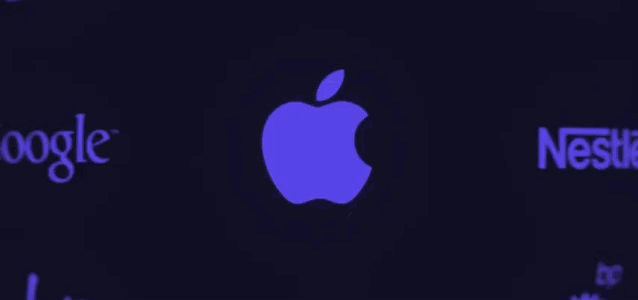 Screen capture from Femke Herregraven, Taxodus (video game, 2013).
Screen capture from Femke Herregraven, Taxodus (video game, 2013).
LC: The most publicized of your works is Taxodus, a online game for tax evasion. At the time, you made the game as a way to materialize and map out what you call "a geography of avoidance"—a study of the obfuscatory strategies used by the finance industry that emphasizes their reshaping of space, place and nationhood. Is the game a realistic simulation? Is it important that it is realistic? Might it also be a valuable tool for people who work in finance?
FH: In Taxodus players are "acting" on behalf of multinationals and have to dodge paying as much tax as they can. By setting up intermediate holdings globally, players reveal potential routes through which multinationals in reality can "neutralize" their tax burdens. Players that escape the most tax rank high in the high scores.
The data in the game—national corporate tax rates, withholding taxes and treaties from countries worldwide—is realistic but the mechanisms to set up companies and calculate income and tax are simplified. In reality there are many more parameters involved on a corporate, national and international level; it would be impossible to incorporate them all in a game. I know some big accountancy firms have tried to develop software that basically cough up a fiscal advice, but it failed because it was too complex and expensive. In reality, fiscal structures are highly customized per company and it seems impossible to make a 1:1 simulation of this tax planning industry.
After Taxodus was launched I know some people from the industry were speculating on these kind of tools that could spark cloud accounting and break the monopoly of the Big Four, giving small accountants a chance. A sort of democratization of fiscal advising. But Taxodus is a beta version and was developed in only a few months. The intention was not to make a hyper-realistic fiscal lawyer bot, but to make the basic principles and mechanisms behind the tax planning industry accessible for you and me. Most of data in the game is not public or easily accessible but behind paywalls that only accountancy firms can afford. For me, Taxodus is a public interface to this data and an experimental research model. I could have made a bunch of data visualisations for example but I wanted to make the audience dodge tax themselves. I think by playing you understand more of how companies cut up their legal bodies in order to organize their income most profitably. When playing, your generated tax route gets uploaded as a fiscal annual report and is accessible in a public database. Taxodus was about making corporate tax avoidance accessible for everyone and facilitating a public platform for dialogue and research. As for the people I know from the industry, so far they have been getting all the high scores.
LC: You are working on a new project on the fiber optic cables which facilitate high frequency trading. Why are you interested in this technology in particular, and how has that research manifested itself?
FH: Optic fiber cable has been around for 30 years and now, in relation to high frequency trading, is probably becoming a thing of the past. New trading lines consisting of radio towers that transmit microwaves are increasingly popping up because they cut latency by up to a millisecond. In high frequency trading this could mean a difference of millions of dollars. Having said that, I think it's important to realize that more than 90% of our data still run through cables in the soil and ocean floors. The "cloud" is more like a never-ending plate of spaghetti. I'm researching this physical backbone of the financial world for some years now, with a large focus on submarine cables. I'm interested in the never-ending rat race for reducing latency and maximizing speed—that is as old as telecommunications itself. The contemporary infrastructural endeavours undertaken to cut down milliseconds are immense in terms of scale and money but surely have their equivalents in the past. The first transatlantic cable from is often referred to as the Apollo Moon project of the Victorian era. I explore how this quest for speed affects our daily life, surroundings, landscapes and geopolitical imagination.

The All Infrared Line – 14 (France), 2012-2014. Coastal fortification from WOII situated at current submarine cable landing point..
In general my work often starts with collecting information and objects that are difficult to obtain, or by visiting places that have a hidden function or are difficult to access. I aim at identifying borders—whether physical or in the information sphere—and finding personal strategies to trespass them. I visit places that play for me a relevant role in the offshore economy—from traditional financial centers, to tropical islands or wanna-be Special Economic Zones. There I draw, photograph and film the often hidden infrastructure that stitches this specific place into the global network of offshore finance. It is a sort of treasure hunt with the treasure being the most boring things you can imagine such as plugs, doors, walls and cables. This interests me very much. Infrastructures—like cables, tax laws or patents—are most of the time utterly boring, technical and hermetic. They run in the background so society can continue with its activities on the foreground. And yet, their implementation and operations are never smooth but create conflicts and inequality. You can find a lot of information about all these things online but working on the ground helps me to get a better understanding of the tensions and power structures that these infrastructures put into play.
Right now, for example, while answering your questions, I'm in the sub-Arctic for a new work that deals with how the financial markets will be influenced by climate change. One element of that work is the emerging possibility to lay submarine cables on the Arctic sea bed because of the melting ice. Although at this moment the actual realization of these cables is problematic on many levels, so plans will probably be realized in the near future. At that point these Arctic cables will shortcut the connection between the financial markets of London en Tokyo that are now linked via the Middle-East or the Pacific. Latency is expected to drop substantially. Global warming is literally opening up new paths for trading algorithms—and surveillance.
LC: When you speak about materiality within finance it leads to a discussion about the materiality of the technologies which facilitate exchange of capital. Often I see you tracing the origins of those materials, such as the plant which produces the rubber for early telegraph cables—which then became the carrier for internet traffic. How does history and technology come into play in your work?
FH: For me, dealing with infrastructures also means dealing with a large timescale. The backbone of the financial world is an accumulation of technology, innovation, capital, labor, conflicts but also time. Historical research plays a large role in my work. I've been working for a long time on how the contemporary geography of offshore financial centers is intertwined with spatial organization of the old colonial British Empire. Half way the 19th century British colonies were connected to the City of London in global spiderweb of early telegraph lines. Many Caribbean islands became parking places for capital in the 1970s because they were tightly wired up in the global telecommunication system and yet distant enough to not contaminate the center of the Commonwealth. This work takes form of collecting historical documents and objects and now, more recently, in producing a series of new objects that deal with the materiality.
Through my work I explore the changing relation between capital flows and materiality. Where wealth once had a material condition and was contextualized by its territory it is now disconnected from a specific place, labour or material production. In finance money is purely made from the circulation of money. It can materialize from itself—it's like alchemy. It's quite interesting how the dematerialization of money in the late 1960s early 1970s coincided with concepts on the dematerialization of the art object. Capital flows are mostly read through a language similar to art: abstraction, signs, ideas, information and linguistic exchange. In my work I intend to melt finance back again into a material condition. Infrastructure is crucial in this process. The backbone that allows capital to be disconnected from material conditions is built from limited resources and manifests itself as highly material in our physical surrounding. The natural rubber you mentioned, was for early telegraph lines in the Victorian age the holy grail, similar to as what coltan is now for mobile phones and devices in our digital age. The sudden and tremendous demand for a specific materials that comes along with the emergence of a new technology activates many new conflicts over materials, ownership and territory. Since finance is now mainly a question of technology there is for me an urgency in stressing the connections between for example latency and plants, trading algorithms and melting ice or colocation and landing points. I think for many of us it's very difficult to understand how money is made in the financial markets. Highly complex financial products, trading algorithms, it's mostly a immaterial black box—even for traders. The irony is that the stakes of financial investments are often material ones. Investors bet on the spread of ebola, wheat scarcity or how real estate prices drops because of rising sea levels. It's funny how bad I was in economy at high school. Those calculations and charts—it just was too abstract for me. I guess that is reflected in the way I approach the financial world in my work. Stressing the connections between finance, places and material conditions is my strategy for getting an understanding of how the financial markets influence and shape our societies.
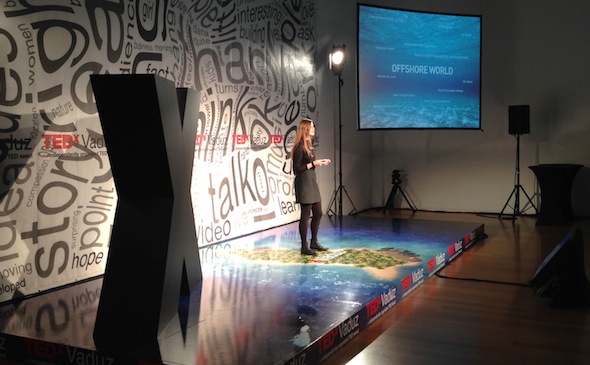
Femke Herregraven at TEDx Vaduz. (Video).
LC: How do you think of your own practice, as artist and as designer and as researcher? Do you find it productive to cross disciplinary boundaries? How do you feel about these terms which are used to describe what it is you do, display of research and how it becomes contextualized in public?
FH: My work gets labelled in different ways and I like that ambiguity. It means its open enough to engage with different fields. Yet, the mechanisms and results in for example art and design are very different. The same work can be shown and evaluated from completely different criteria. This can be complicated as maker but it creates a rich feedback loop at the same time. In my practice I create research in the form of indexes, maps, texts, interviews, drawings, photos and videos. Sometimes the research is the actual work, other times I make a new work in the form of installations, publications, games or prints. I think of my work as tools or manuals that can help me—or someone else—navigate, deconstruct or reflect on complex matters such as the financial world. An emerging question is how I present my work online or through the format of an exhibition. I guess because of my background in design it is not always natural that the work is being displayed instead of being used.
Talking about the cross-disciplinary, I'm also part of Bitcaves, a collective for design and research. Basically it's an umbrella for all sorts of things: commissions, residencies and cross-disciplinary collaborations. Next to working individually it's for us valuable to be part of a collective. It's nice to be able to switch between different modes of working and collaborate with different types of makers. In general I connect with people from different disciplines through my work, such as academics, business people, journalists, craftsmen, financial experts. When you dive into something thoroughly you naturally end up with a mosaic of people outside of your field. Sometimes you meet people you prefer not to work with but it's unavoidable because you clutter together around a very specific interest or expertise. Around your own work you naturally construct some sort of family. A family is by nature a diverse and cross-disciplinary social group that no member entered voluntary. Yet, the dynamics and exchange within that family—even with the pedantic uncle, nervous aunt or on-hormones-tripping cousin—are, for me, crucial as a human being and as an artist.
Questionnaire
Age: 31
Location: Amsterdam/Kirkeness/Murmansk
How/when did you begin working creatively with technology?I actually grew up around analog tools. There was always lots of carpeting and construction going on which I liked a lot. So for me it was probably more software: I think it was Photoshop in high school. I was so amazed by that stamp and air brush function, I was clicking and dragging for hours.
Where did you go to school? What did you study?
I did a bachelor in graphic design at Artez Arnhem and a master in design at Sandberg Institute in Amsterdam. Both studies have a strong research component in which students are challenged to developed their own questions and research around things that they feel personally engaged with.
What do you do for a living or what occupations have you held previously?
I'm an artist/designer/researcher. Next to that I teach design research one day a week at Artez Arnhem, and have done that at Sandberg Institute last year. I have also worked part time in a butchery for 7 years. Which looking back now was actually very useful. Meat is also at the center of a very complex industry. In those twelve hour working days I think I unconsciously learned some skills and strategies that have proved their usefulness today. Kinda from meat infrastructure to money infrastructure you could say ;-)
What does your desktop or workspace look like?
A never ending mess—which is very comforting to me.
Kari Altmann's Insta video classic for @rhizomedotorg
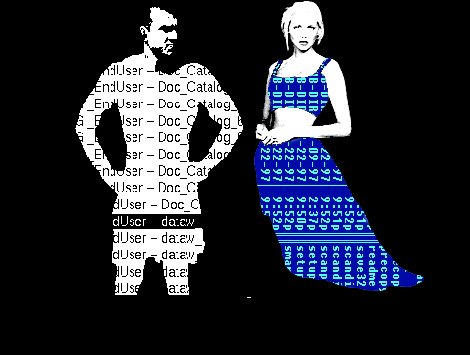
Classic browser-based work Agatha Appears (1997) by Olia Lialina
Voting for the five $500 internet art microgrants begins today.
Rhizome community members (you'll need to log in to vote) will narrow the 140+ proposals to a list of 20, from which our (to be announced soon) special guest juror will award five microgrants. Each voter will have three votes to be apportioned to three separate projects — once you vote for something, it disappears from the list. The proposals are spread out over 19 pages, but their order randomizes with each voter.
As we've noted before, the proposals were beyond heartening. In particular, the diversity of projects — from a parody celebrity game, to a weblog for a cooling tower sculpture, to gifs, to culture jamming — illustrates the richness of browser-based work in 2014.
So, go vote! And, best of luck to the entrants.

Emilie Gervais's proposal
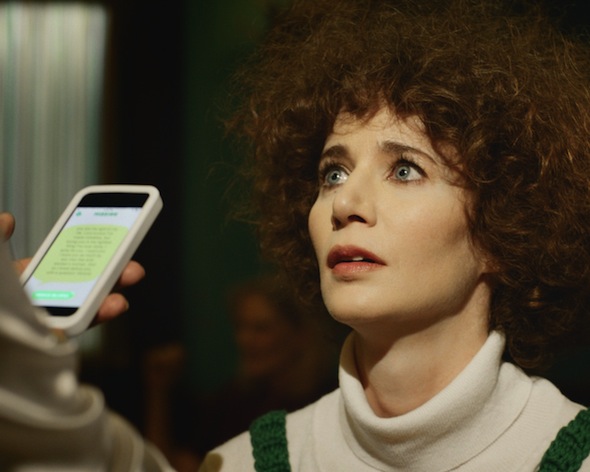
Miranda July, Somebody, 2014 (still, featuring July). Video, dir. Miranda July. Courtesy the artist and Miu Miu.
"Texting is tacky. Calling is awkward. Email is old." —Miranda July
In Miranda July's 1998 experimental video The Amateurist, a young woman with a jet-black pixie haircut in a stiff professional dress (played by July) studies a TV set displaying a fuzzy surveillance feed of a blonde woman (also played by July), who is squirming in the corner of a small cell. While speaking to the camera, the pixied professional reels off all sorts of absurd quantifications and explanations of the surveilled woman's movements. She maps her emotions to a numbered grid, psychoanalyzes her behavior, quips about her habits, and consistently runs roughshod across boundaries between doctor and patient, subject and object, viewer and viewed, public and private, in what is ultimately an excessive examination without any apparent justification. Since the video was produced, July's body of work has expanded from video and performance to include online works, novels, and feature films—all of which attempt to dissolve boundaries between fictionalized personae, or between the artist and her audience. It's significant to note that July started out in the experimental-video scene of the '90s, since so much of her work is about how the adaptation of new technologies affects us on a very personal level. Regardless of medium, her works reflect how broad social changes inflect our most intimate relations.
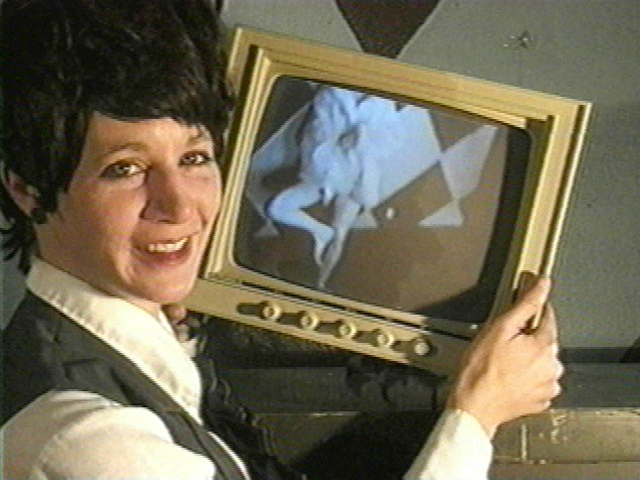
Miranda July, The Amateurist (1998). Still image from single channel video.
July's new iOS application, Somebody™, which the New Museum is proud to copresent as part of a distributed international launch with multiple international partners (see list below), continues these profound investigations into the ways technology mediates our interpersonal communications.
July describes this new messaging service in the following way:
"When you send your friend a message through Somebody, it goes—not to your friend—but to the Somebody user nearest your friend. This person (probably a stranger) delivers the message verbally, acting as your stand-in."
Somebody is available as a free download via the iTunes Store, and somebodyapp.com can be visited for an overview of the work.
An accompanying video by July will also be screened in the New Museum's Lobby. The artist will speak about Somebody at the New Museum on October 9 (details to come).
Notes about Somebody:
• You can choose actions and directions for your stand-in, such as [cry] or [hug]—or write your own.
• The recipient always has the option of declining a delivery before the message is set in motion, if now's not a good time.
• The first sentence of the message is automatically "[Recipient's name]? It's me, [Sender's Name]," thus reminding the stand-in to assume the identity of the sender.
• Somebody uses GPS to locate your friend, then presents you with photos and performance ratings of nearby users so you can choose the best possible delivery person for your message.
• If there's no one nearby, you can choose to "float" your message indefinitely. Users interested in being a stand-in can browse nearby floating messages and pick one to deliver.
Somebody was created with support from Miu Miu. Official Somebody hotspots so far include Los Angeles County Museum of Art (with a presentation by July on September 11); the New Museum (presentation on October 9); Yerba Buena Center for the Arts, San Francisco; Portland Institute of Contemporary Art; the Walker Art Center, Minneapolis; and Museo Jumex, Mexico City. Museum-goers are invited to send and deliver messages in these spaces where there are likely to be other users.
About Miranda July
Miranda July is a filmmaker, artist, and writer. She wrote, directed, and starred in The Future (2011) and Me and You and Everyone We Know (2005), which won a special jury prize at the Sundance Film Festival and four prizes at the Cannes Film Festival, including the Caméra d'Or. July's fiction has appeared in the Paris Review,Harper's magazine, and the New Yorker; her collection of stories, No One Belongs Here More Than You (2007), won the Frank O'Connor International Short Story Award and has been published in twenty-three countries. The nonfictional work It Chooses You was published in 2011. In 2000, July created the participatory websiteLearning to Love You More with artist Harrell Fletcher, and a companion book was published in 2007; the work is now in the collection of the San Francisco Museum of Modern Art. She designed Eleven Heavy Things, an interactive sculpture garden, for the 2009 Venice Biennale, and in 2013, more than a hundred thousand people subscribed to her email-based artwork We Think Alone (commissioned by Magasin 3, Stockholm). In 2014, she debuts the audience participatory performance New Society at the Walker Art Center in Minneapolis and launches the app Somebody, a messaging service created with the support of Miu Miu. The First Bad Man, a novel, will be published in January 2015. Raised in Berkeley, California, July lives in Los Angeles.
Sponsors
First Look is made possible, in part, by the New York State Council on the Arts with the support of Governor Andrew Cuomo and the New York State Legislature.

Additional support provided by the Toby Devan Lewis Emerging Artists Exhibitions Fund.
Art Project 2023 from Enxuto & Love on Vimeo.
The latest in an ongoing series of themed collections of creative projects assembled by Prosthetic Knowledge. This edition brings together works dealing with early computational sculpture, looking at objects designed and fabricated with the computer. Add your suggested additions in the comments below.
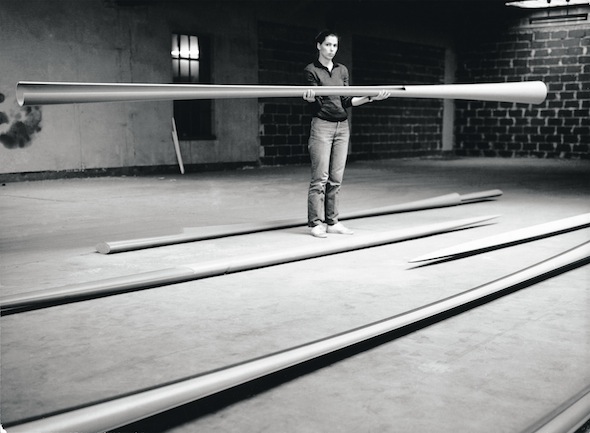
Isa Genzken holding one of her Hyperbolos in her studio in Düsseldorf, 1982.
As with all fields of the arts, the role of computing in the field of sculpture and form-fabrication is rapidly growing. 3D printing is the most obvious example, with its now familiar method of taking a 3D design file and producing a physical object to match, line upon line from the supporting surface upwards. Also, with the assistance of programmable electronics, installations of arranged matter can be maneuvered into various forms and performances, receptive to local stimuli or external data, all of which is connected to an out-of-range laptop orchestrating the spectacle.
For this submission, though, the aim is to explore some of the earliest examples of computing and sculpture, by artists who were in a position to explore the potential in an at-the-time esoteric field. These artists glimpsed the possibilities and problems that emerge when the object becomes a digital entity, long before the rise of 3d printing.
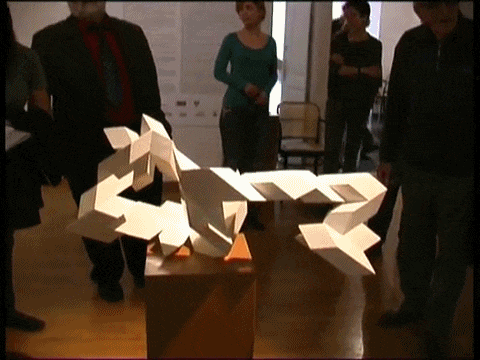
Work by Zdeněk Sýkora from the retrospective exhibition "Barva a Prostor" ("Color and Space"), Muzeum umění Olomouc, 2010.
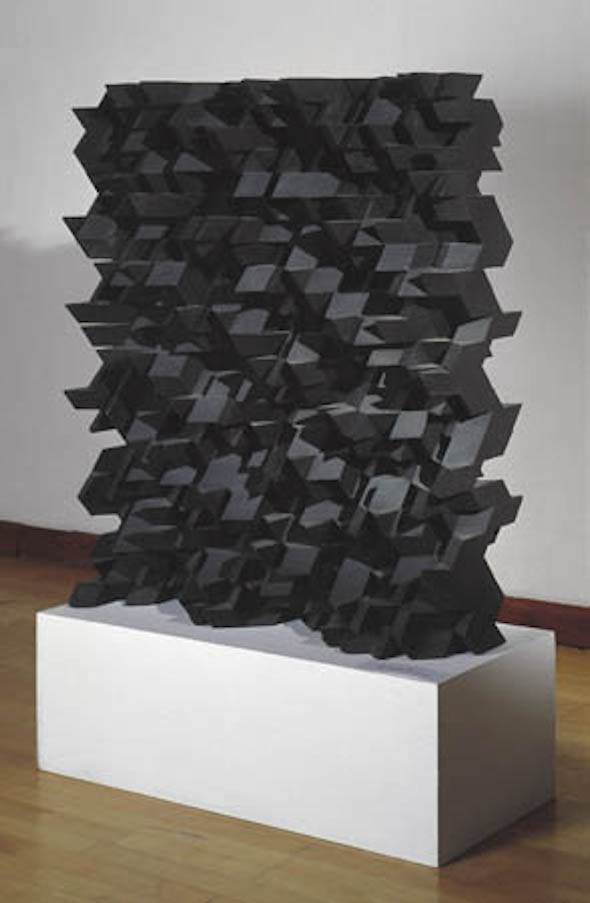
Structure Sinusoidal, 1965
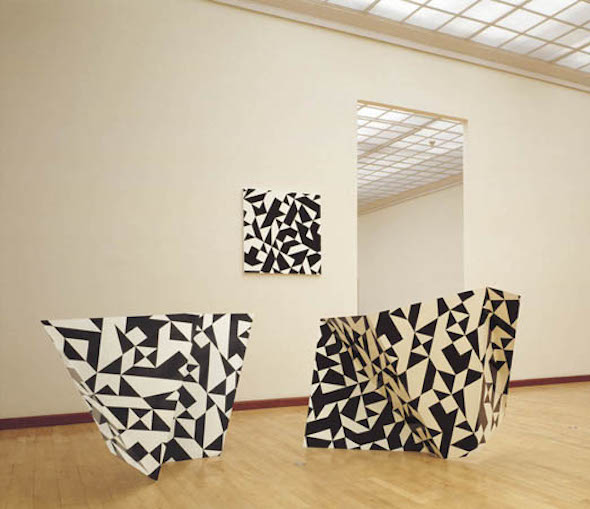
Topological Structures, 1969
Pioneering Czech artist Zdeněk Sýkora was apparently the first artist in his country to utilize a computer (in 1966) in his works, from painting to sculpture. Via Monoskop:
In 1964, Sykora collaborated with mathematician Jaroslav Blazek to create visual computer-aided structures which used algorithms to find different combinations of abstract elements within predefined parameters. The result echoed the aesthetics of Op Art, yet his methods were his own. Then around 1973 he abandoned structural work and began to make paintings characterized by clusters of interwoven lines. These lines - everything from their hue, length, thickness, curve, direction—were determined by a computer program that mixed equal parts randomness and precise mathematics.
Here is a video (in Czech) featuring a tour of a retrospective exhibition at the Museum of Modern Art in Olomouc, Czech Republic. Whilst there is a focus on the artist's paintings you can clearly see some of the computer-designed sculptures around. Zdeněk Sýkora's website; original post from PK.
Robert Mallary — Quad Series (1969)
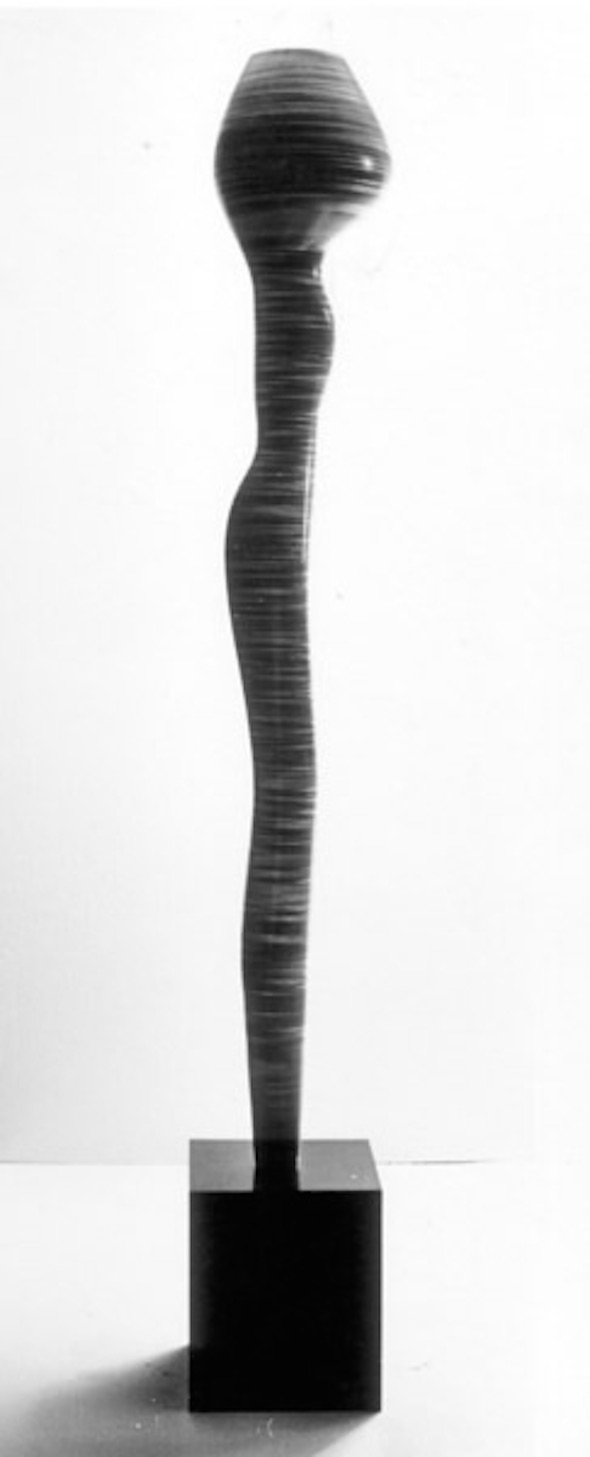
Quad II, 1968. 711⁄2 x 11 in. TRAN2 computer sculpture in laminated veneer.
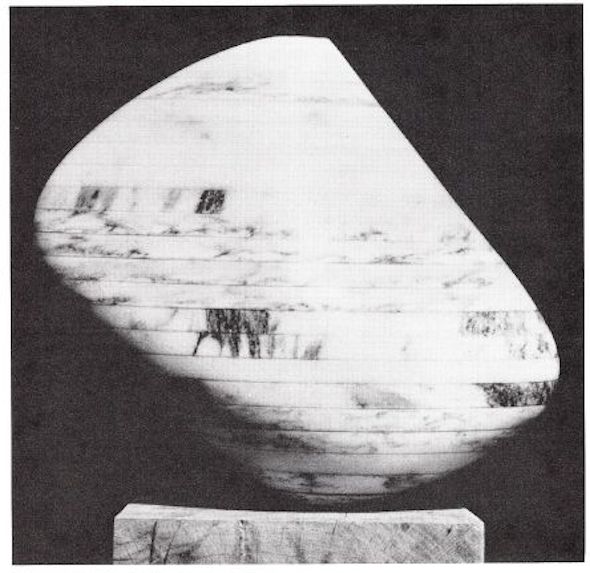
Quad IV (1970). Laminated slabs of computer-determined marble.
American artist Robert Mallary developed a computer program that could be used to design three dimensional forms by stacking two dimensional shapes, a process not so dissimilar from some 3D-printing approaches today.
The following text is taken from an interview with Mallery in the book Artist and Computer:
How/why did you become involved with the computer in producing art?
...I turned to the computer in 1967 on learning for the first time about its ability to generate and transform images. Almost immediately I realized that my earlier idea of multi-planar image synthesis could be used to describe three-dimensional forms within the computer by slicing and stacking them as two-dimensional shapes—something like a contour map. The result was my computer sculpture program TRAN2, the first version of which was written in 1968 for the IBM 1130 system at Amherst College.
Below is an extract from "Computer Sculpture: Six Levels of Cybernetics", a piece written by the artist for Artforum in May 1979.
TRAN2, the computer sculpture program which has occupied me and my student associates for the last eighteen months or so, is still at the crawling stage in terms of programming and hardware sophistication, but even at that it has opened up several possibilities for sculpture which were not available in the past. It can also be said in its favor that it embodies, even if only in skeletal form, the essential requirements of an authentic computer sculpture program. It provides several modes of data input; it gives the computer a full, three-dimensional description of the material it must work with; it provides ways to process, modify and reshape the form description input material; and it provides several kinds of graphic output usable for evaluating the computer’s productions and for physically constructing an actual sculpture if the drawings are sufficiently promising.
If a computer is to make sculpture, it must be given either a comprehensive numerical description of the basic material it is to work with, or the means to generate this material for itself. In fact, our TRAN2 program does both, using contour “slicing” as the basic method of form description and form generation. In effect, the form is sliced—much as an apple or a chunk of baloney might be sliced—into a series of thin cross sections of equal thickness which can then be graphed, digitized and encoded on computer punch cards. It is also essential that each of the slices has an axis point to position it relative to all the other slices on the vertical axis. It is by means of this “stacking” of two-dimensional data that the program converts standard computer graphic capabilities to the requirements of three-dimensional form description.
TRAN2 uses between forty-eight and a hundred contours. This is not enough for a smooth, continuous definition of the form (i.e., without a visible demarcation, or “step,” between one contour and the next), but it is a practical minimum considering the limited capacity of the Amherst College IBM 1130 computer for which TRAN2 is programmed.
Seek— Nicholas Negroponte with the Architecture Machine Group , MIT (1969-1970)
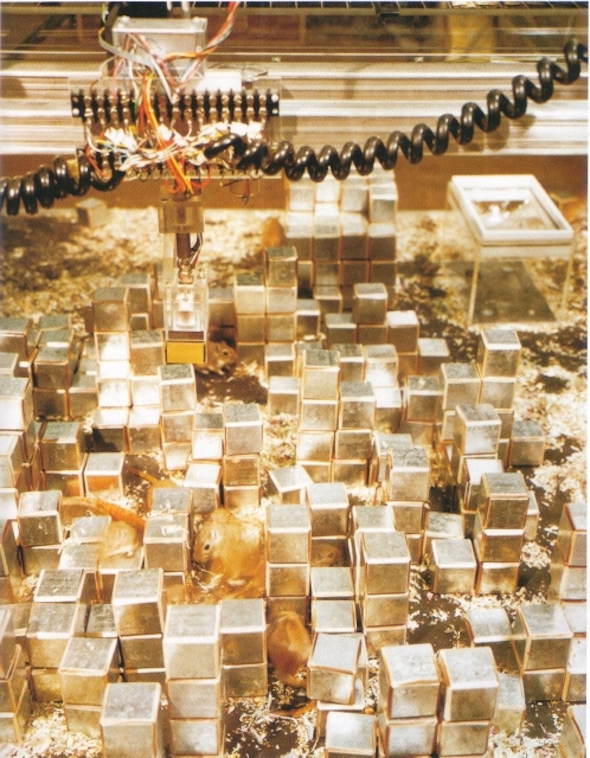
Seek is an installation by artist Nicholas Negroponte in collaboration with the Marchitecture Machine Group, originally debuting at the "Software" exhibition (1970) at the Jewish Museum in New York. The installation consists of several gerbils inhabiting an enclosed space filled with blocks that are arranged and rearranged by a robotic arm. As the computer manipulates the environment, in a sense, the piecee becomes a sort of Minecraft for rodents.
The project was described in the catalogue for "Software" as follows:
Seek is a sensing / affecting device controlled by a small general purpose computer. In contrast to an input/output-peripheral, Seek is a mechanism that senses the physical environment, affects that environment, and in turn, attempts to handle local unexpected events within the environment. Seek deals with toy blocks which it can stack, align and sort. At the same time, these blocks form the built environment for a small colony of gerbils which live within Seek's three-dimensional world.
Unbeknownst to Seek, the little animals are bumping into blocks, disrupting constructions, and toppling towers. The result is a substantial mismatch between the three-dimensional reality and the computed remembrances which reside in the memory of Seek 's computer. Seek's role is to deal with these inconsistencies. In the process, Seek exhibits inklings of a responsive behavior inasmuch as the actions of the gerbils are not predictable and the reactions of Seek purposefully correct or amplify gerbil-provoked dislocations.
A PDF of the Software catalogue can be found here. Other photographs can be found here. Original post from PK.
José Luis Alexanco — MOUVNT Series (1969-1973)
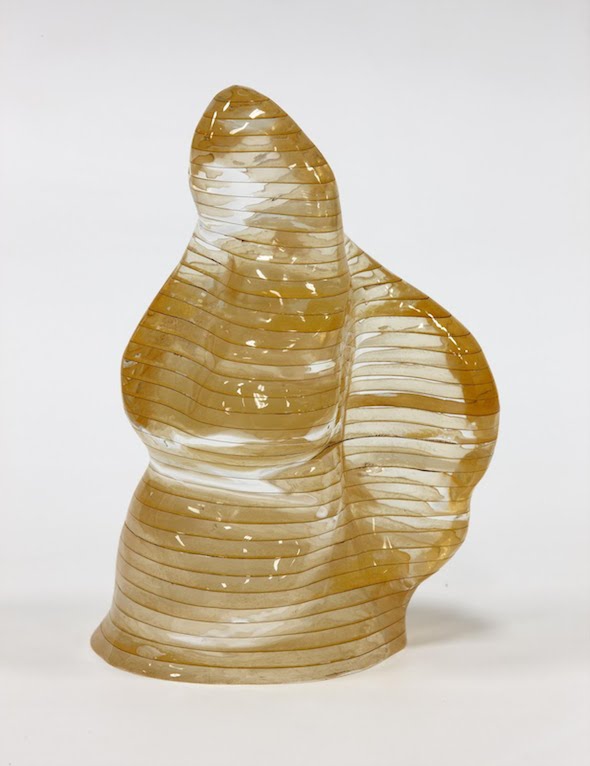
Escultura MOUVNT, 1972.

Escultura MOUVNT, 1972.

Escultura MOUVNT, 1972.
Spanish artist José Luis Alexanco created a series of works by using a computer program that manipulated the contours of the human figure. From the website of the Museo Reina Sofía in Madrid:
José Luis Alexanco’s work was already involved in the application of computer processes to human figure representation when he joined the first year of the Seminar on the Automatic Generation of Plastic Forms (1968-1973) at the Computer Centre of the Complutense University of Madrid. Of all those taking part in the seminar, Alexanco was the only artist able to do his own programming. The MOUVNT sculptures are a demonstration of his artistic investigation into computer-generated shapes and forms. To create them, the computer began with basic shapes taken from the synthesis of the human figure, and then applied transformations created by turning, expanding, transposing and interpolating and combining the shapes. Finally, the MOUVNT sculptures materialised as resin-coated laminates, through a process of feeding the computer information about the contours of the forms and transformations, meaning Alexanco could create around three hundred different sculptures from a single method. The Museo Reina Sofía keeps seven sculptures from the series, and the MOUVNT computer programme (1969-1973) that was used to generate them.
A program code itself—the algorithm that generated Alexanco's three-dimensional forms from human shapes, also part of the Reina Sofía collection—has become an artistic artifact:
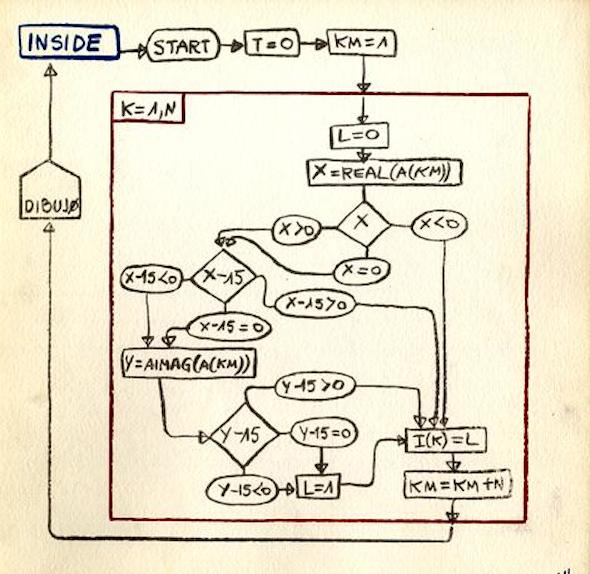
Below is a computer generated plotter sketch for several sculptures, found in the August 1977 edition of Computer Graphics and Art (more on that here).
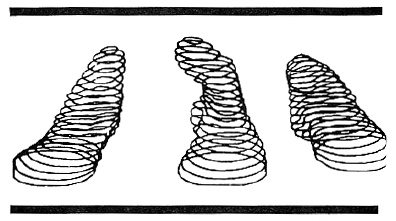
Here is a video showcasing many works by the artist; more works can be found at the Museo Reina Sofía website here.
Ron Resch, Vegreville Pysanka (1973)

This Ukrainian-style rotating Easter egg made by Ron Resch in 1973 was the first public sculpture designed with 3D design software. From "The World Largest Easter Egg and What Came Out of It" by Jim Blinn published in 1988 in IEE Computer Graphics and Animations:
The problem was how to build an ellipsoid, but an actual replica of a chicken egg on a grand scale… Fortunately, Resch had already been creating and experimenting with the modular tiling of general surfaces in 3D with a view toward architectural applications… Resch chose to build the egg out of flat aluminum plates. The question then was how to design a pattern of triangles that could be fabricated and connected together to achieve the egg's shape, decorative pattern, and structure, while still preserving his constraint of modular tiling…The program of Resch and Christiansen just specified some variable for the folding, and it simulated whatever surface resulted from the rigid polygon mesh.
The result was the first physical structure designed with computer-aided geometric modeling software.
Original post from PK.
Isa Genzken's Ellipsoids and Hyperbolos

Grün-orange-graues Hyperbolo "El Salvador," 1980.
Now featured as part of a major touring retrospective opening soon at the Dallas Museum of Art, Isa Genzken's early work included a series of wooden sculptures produced with the aid of the computer. Her 1976 wooden sculpture (Ellipse No. 1) was shown alongside a computer plotter drawing in which two curved lines were drawn in a spear shape.

Computerzeichnung (Computer Drawing) (1976). Dot-matrix printout on continuous paper, 14 3⁄4 × 172 7/16" (lost).
From there, she went on to make two series of wooden sculptures—Ellipsoids, which have contact with the floor only at one point in the middle, and Hyperbolos, which touch the floor only on their ends—that were constructed from templates designed on a computer. This was done with the collaboration of a physics student, Ralph Krotz, and cabinet maker Hermann Hertel. From the catalogue for "Isa Genzken: Retrospective":
A letter dated October 4, 1979, in which Genzken again explained that she wanted to "call on" her engineer friend's "arts of calculation" in order to create mathematically correct sculptures, provides a glimpse into the production process that followed the technical drawing. On the computer printout, which represented the sculpture at actual scale, for example, Krotz entered longitudinal and cross-sectional dimensions every ten centimeters. Genzken then trans- formed these into small wooden molds that corresponded to negative forms of the sculpture segments, which, in combination, illustrated the curve. In Hermann Hertel, the cabinetmaker at the Düsseldorf Academy, Genzken found the crucial third person, a woodworking specialist who could help her to realize her sculptures (fig. 13). He would first glue up a rough wooden shape in the maximum dimensions of the desired form and then remove what was necessary, constantly checking against Genzken’s negative templates. Once the final shape was achieved, it was painted in different colors and textures in an equally complex process in which Genzken again collaborated with a specialist.
For more about "Isa Genzken: Retrospective," see this conversation by Hannah Black and Tyler Coburn for Rhizome. You can purchase Isa Genzken: Retrospective here.


Debo Eilers/Brian Kokoska at American Medium from Arjun Srivatsa's and Nick DeMarco's Instagram feeds

#Stiff #Season 10 #Episode 228 #2000 from Computers on Law & Order
"Tabularium," a group exhibition curated by Alana Kushnir, runs through September 13 at Slopes in Melbourne, Australia.

"Tabularium" exhibition view. Left to right: Alana Kushnir, Tabularium Archive (2014–), Rachel de Joode, Hanging Marble (2014), Katja Novitskova, Shapeshifter X (2013) and Shapeshifter V (2013), Jon Rafman, Annals of Time Lost (2013). Photograph: Christo Crocker.
Slopes is temporary gallery, set to be demolished.
Tabularium
a little conceited
becomes an introduction to post-internet, for doz dat slept
utilitarian dissonance as the work revolved around a library
library had the most presence
and was the title of the show, and by the curator
referencing ancient + classed knowledge management, the heaviest work in the show
is a credibility box
ultimately it set out to look at a moment in time
maybe in contrast to the fluidity of the internet

A website can go up and down whenever, non-committal, a book is published and then exists—becomes an object—lasts—is static—refusal of the internet's nature
lock away a painting to keep it safe
lock away a website to kill it
the information is a sculpture, so you don't have to touch it, you don't have to read it
it signifies knowledge
jon rafman signifies knowledge

Left to right: Eloïse Bonneviot, My Forensic Steps 2, (2014), digital print on silk. Heman Chong and Anthony Marcellini, Twenty Plots for Things To Come, (2013–present), online film, unknown duration. Ry David Bradley, Flowers for Ukraine (2014), ink transfer print on suede. Photograph: Christo Crocker.
Anthony Marcellini and Heman Chong's Twenty Plots for Things to Come pre-emptively eulogises knowledge. From a counter position to Tabularium, the website/video recycles and displays images from science and technology museums, playing them in random sequence until the original image links die.
I feel like I am walking around inside an install shot. The works are beautiful; they are also cool, light, tech, premium, and optimized for the screen.

Ry David Bradley, Flowers for Ukraine (2014), ink transfer print on suede. Photograph: Christo Crocker.
You don't need to remember anything because Wikipedia exists, Ry David Bradley knows this. Wikipedia won't remember the 10 hours that David Bradley's delicate tulip was the picture for Ukraine.
You don't need to remember what Amalia Ulman said,
You don't need to know what Simon Denny's show looked like.
You just need to remember Amalia Ulman and Simon Denny.
Perhaps Tabularium resists the liquidity of user-edited personal branding, preferring static forms of accountability: books reserved for contextual irreverence and future hubris.

Katja Novitskova, Shapeshifter X, 2013 (left) and Shapeshifter V, 2013 (right), broken silicon wafers, epoxy clay, nail polish, appropriated acrylic case, appropriated wooden capital. Photograph: Christo Crocker.
Katja Novitskova retroactively constructs an aura around unknown information. Shapeshifters takes broken silicon wafers and turns them into tools/weapons. Exhibited inside display cases on wooden capitals, they become museological cyber antiquities: semiconductor material manufactured to transmit information becoming information itself. Like maintaining web 2.0 currency or taking up space as a survival tactic, Novitskova builds her own myth. Displayed next to Rafman's Annals of Time Lost, both artists' works present a mythology of pointing signifiers. Rather than point at anything in particular, the works suggest a dissonance between historicizing information/materials/artefacts before vs after the internet.

Eloïse Bonneviot, My Forensic Steps 2, 2014, digital print on silk. Photograph: Christo Crocker.
You read a review in the form of a poem, and it ended: Tabularium refers to a building from ancient Rome, made to store the legal documents of the fallen civilization. Tabularium's an exhibition with the foresight to plan its own funeral. Curator Alana Kushnir has put together a show that compellingly, if incohesively...
[During the editing process, I asked Hamishi and Aurelia to clarify the line "books reserved for contextual irreverence and future hubris." They wrote, "Offline forms of accountability = finality, print. Once the documentation has been taken and the show is over, an artist can recontextualise it to fit the current moment through editing and coding. Tabularium purposefully resists this. Finality has become hubris, finality has become contextual irreverence simply because of the impossibility of non-conflicting opinion when everyone is a blogger." —Ed.]

Introduction to net.art (1994-1999) (1997-1999) - Alexei Shulgin & Natalie Bookchin
The latest in a series of interviews with artists who have a significant body of work that makes use of or responds to network culture and digital technologies.
Andrea Crespo, Liquidation (2014).
Your work explores the ambiguities of the cyborg's promise—how it can reinforce patriarchal gender systems as well as liberating us from them. Can you talk about that specifically in relation to Eden, where "lust" appears as an apparatus, a series of luxury hi-tech prosthetics, rather than as a possible relation between bodies?
I wouldn't oppose the apparatus to a possible relation between bodies. I would say that it mediates, complicates, and likely crystallizes relations in a particular way. Pornography in general is just the technological mediation of normative desire, whether it's through dildonics or other viewing apparatuses. All these means are very much capable of re-inscribing everything in very traditional ways. But they are not irredeemable. It's not like the multiplication of desire through technological means is always conformist. It may subvert itself along the way.
A lot of the proliferation of desire just happens through subtle de-territorializing forces. Alien-signal super-stimuli replace normative desire. Things can happen through chance encounters with things that are outside what you are supposed to desire. The validation of sexuality through capitalism and markets of course can end up reifying gender—but market niches need to expand, and trends change. The spread of queer politics and all forms of identity politics attests to these kind of forces. If anything, I think that identity politics are still too tied to certain narratives, even though they're fissuring and multiplying. Even within for example the trans community there are so many different types of trans, even within LGBT in general there are so many variations and so many people that deviate from the mainstream conception of that. Hence you have the development of new identities like otherkin, theriantrope, transabled, multiple system, furry, asexual, etc. These communities draw from LGBT identity politics, and often their membership (by self-labeling) overlaps.
There are things that come into people's lives and disrupt their pre-existing patriarchal desires. Vague generalized sexual/gender/identity alterities (and/or disorders) are a side effect of infospheric eroticism.

ΑΩ (2014). Playstation 3 game disc case, images, lottery ticket, quote by Elliot Rodger (UC Santa Barbara). From the series Complex Cases.
In your work Complex Cases, you invoke spectacular masculine violence, displaying quotes from the Columbine killers, Adam Lanza, Elliot Rodger et al on modified video game cases—but the cases are empty. It's as if, going beyond the liberal critique of video games, the hyperviolence of the game is actually hard to distinguish from the ubiquitous hyperviolence of race, gender, work, money. Could you say more about this work, and the use of the school shooter manifestos?
In the cases, I investigate various threads that appear and often reappear in the trajectories that lead to spectacular male violence. The quotes on the cases vary: some of them come from forum posts because that's all they left behind. Adam Lanza only left behind traces of data on the internet, there are no real letters or manifestos.

Aquilegia (2014). Playstation 3 game disc case, images, 100mg Fluoxetine, plastic wrap, acrylic paint, quote by Eric Harris (Columbine). From the series Complex Cases.
Complex Cases is a pun, because all we have are these trajectories that seem to point towards certain narratives in common between the school shooters, common sentiments, and even exposure to certain cultural trends and means that lead up to their violence. I don't think there's any way we could ever really describe with nuance what happened, but I'm really just trying to expose different threads that appear and reappear. A lot of these seem to be narratives that reinforce themselves, especially as the school shooter phenomena becomes naturalized, to the point where you see them imitating each other. For example, Adam Lanza would make charts; he had a spreadsheet of all the school shooters with ranks by deaths, and injuries, as well as what kind of weapons they used.
I'm really interested in hyperstitious narratives that reinforce themselves in reality through belief. A hyperstitious narrative is one in which the narrative immanentizes itself, for example how sci fi provides the inspiration for people in STEMs to produce products. It's this feedback relation. That's also how psychoses build, it's just reaffirmation, coincidence, intensification, to the point where a lot of these school shooters believe that they're on a special path and that there is a theology behind the doom that they are going to bring upon people. There's this positionality of the subject as the victim of some kind of cosmic tragedy that needs to be avenged through retaliation. It's clichéd revolutionary, in the Fight Club conception of just "fuck shit up," so not actually revolutionary but very heavily politicized.

Dialing from the series Sis (2014).
In Sis—a psychiatric mood chart augmented with hand-drawn hentai characters—and in the first-person account Wilderness Therapy, you refer to the diagnostic categories of mental illness, especially as they are used on young people, and specifically on you. Do you see a relation between this and other forms of identification, for example gender, or the avatar?
All of the above are prescriptive as much as they are descriptive. They situate one within discourse. Mental pathology and gender define boundaries for behavior. Sometimes it's comforting, like knowing one's place within a particular cosmology. Though these prescriptions might present themselves as a way of knowing oneself better, they often end up regulating behavior, or actualizing themselves through bodies that come in contact with them. They congeal, yet they are unable to totalize everything into themselves.
The avatar can exist more fluidly than the gendered body and allows escape from some, not all, of the body's ontological entrapments. The avatar functions similarly for those who may actually be suffering from mental illness. For example, someone who struggles with face-to-face communication might find remedy in expressing themselves through avatars in online worlds. It is for this reason that many—those on the autism spectrum for example—find vehicles for expressivity through fictional characters.
Mainstream gender categories and identity categories are still very much about aligning yourself to a prepackaged narrative of how your brain works, or how your desire works, or what you like, or what you are like.
Your work looks at technology in a way that seems aesthetically aligned with what used to be called post-internet art, but is different in that it seems guided by emotional or political concerns rather than form alone.
I think the assumption that post-internet experiences, so to speak, must be perceived through a detached lens is kind of an error because these experiences really do influence people and are formative. They involve intense emotions and not just images on screens. There's very much a material base, we can't forget our bodies and their materiality and responses to codes on the internet: codes of all kinds, image codes, representational, sexual, pornographic, biopolitical. I think of net art and their various experiments with hyperlinking and hypertext. That's what leads to conspiratorial or very horizontal associative thought process, where narrativizations can come together through various sources and reinforce each other. These stories become captivating enough to the point that people's lives are structured and mandated by them, whether the stories are diagnostic categories, or political theologies, or stuff like that.

Dialing from Sis (2014).
Your work features manga images of unreal or hyperreal bodies, for example in the Holistic Cures series where you combine psychiatric and alternative medication with hentai characters. But here they're hand-drawn and kind of de-eroticized. What's your interest in these kind of images of bodies?
I feel in a sense like I liberate them from this context of just being imaginary entities that are to be masturbated to or to be fetishized in one way or another. As much as these representations are used for those means, you also see people identifying with them or using them as avatars, whether that has an erotic component or not. These beings do take on lives of their own. Inori Aizawa, the Internet Explorer girl, embodies the browser and is from a Microsoft viral campaign, but people produce fan art about her. I think it's fascinating that these fictional bodies have so much potential for identification and eroticization, or even total animism, where people really ascribe living qualities to those things and end up becoming or mimicking them. The images became the substrate for my dissociative tendencies; I produced other selves.
That's where my interest in otaku culture really comes from, or in nerd culture in general: The relationships between/within bodies, of embodiment, where all these interchangeable ever-changing images dictate the body. They're recombinant. Mostly they're imbricated in these profit-making contexts, but I'm really interested in how people will take these characters and make them their own. Sometimes these narratives really start to penetrate their personal lives and their appearances, and these characters take on lives on their own, through affinity or whatever.
Images of bodies become recombinant, as do bodies themselves, and everything is becoming fragmented and up for grabs. I'm kind of nihilistic so I can't say it's totally liberatory. I feel like it's also network forces and economic forces undoing things and restructuring things, maybe these are more emergent processes that may interact with other political struggles but there may be darker forces at play as well.

From Holistic Cures (2014).
Questionnaire
Age
21
Location
New York
How/when did you begin working creatively with technology?
I began making drawings in MS Paint around the age of 4.
Where did you go to school? What did you study?
I'm currently working towards my BFA in "Digital Art" at Pratt Institute.
What do you do for a living or what occupations have you held previously?
I am primarily a student, and currently hold a job on campus. I also do tech support on weekends for a software/media business.


The Internet Art Microgrants Juror
Votes are tallied, and we're pleased to announce the 20 finalists voted on by you to compete for five $500 Internet Art Microgrants. Now, our guest juror, Helsinki-based artist Kimmo Modig, will choose the awardees from your selections.
We invited Kimmo to adjudicate this inaugural commissioning program for brower-based work because of his sensitivity to a wide range of artists' practices and his understanding that even when art seems really silly it still can be DEEP 4 U:
To think that art is just for lulz in a world full of unfathomable suffering and constant exploitation is hard and some might say, unethical. In order to avoid these issues, we've created these value systems, complex ever-changing hierarchies, which are ultimately ways of proving that art matters. When I work with institutions, I try to always work directly with individuals, so I know that there's someone who hopefully understands what I'm trying to do.
In keeping, we expect his selections to demonstrate breadth and creativity. For more on Kimmo's practice, see Jesse Darling's Artist Profile.
The 20 proposals Kimmo will be considering are:
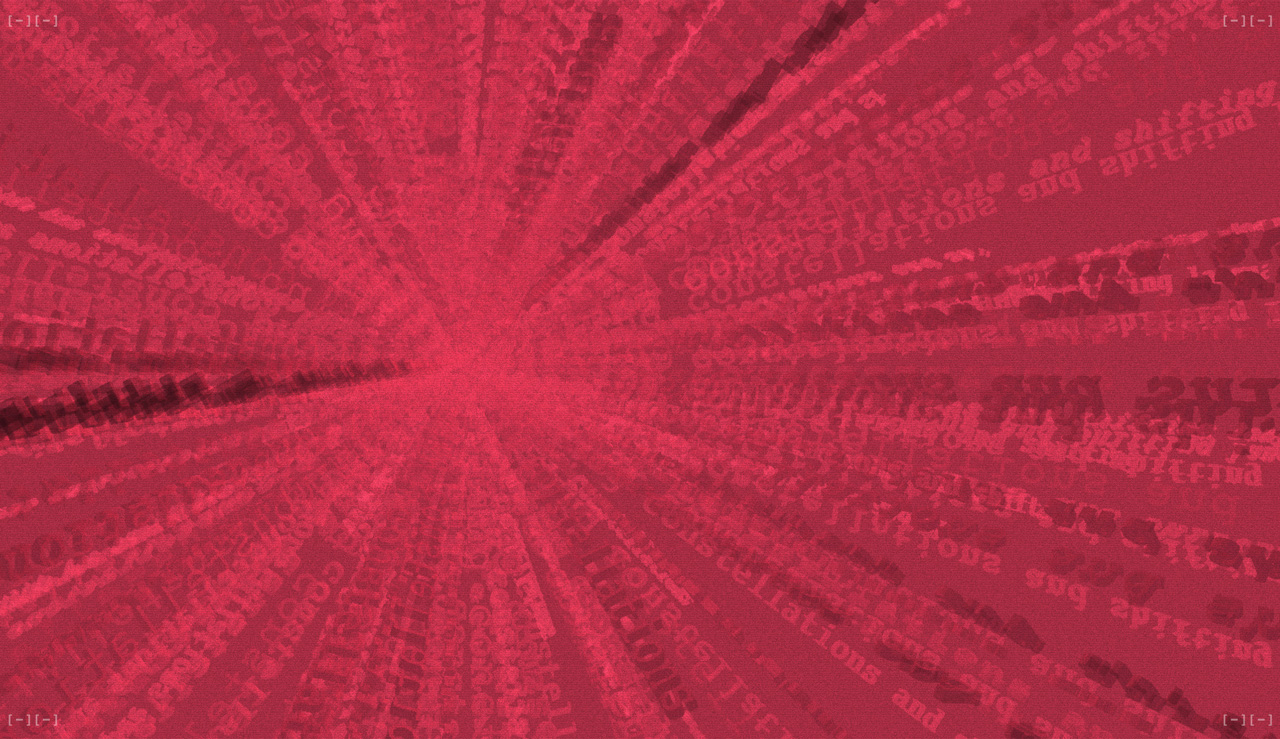
A. Bill Miller, new Grid works
I propose to continue my work investigating browser-based image/text relationships with a new suite of web pages. Following my projects "Sentences on Conceptual Art in gridfont7" and "gridCycles.net" I will explore how meaning is generated through language and image within the browser. This specific work will engage with a combination of CSS animations and Javascript that uses WebGL. It will engage typographic marks as 2D and 3D assets while engaging flat and dimensional browser-based environments. Although the desired outcome hasn't yet been determined, the work will likely parallel some of my previous work aesthetically while investigating my new interests in content.

Acid Rain, MPAC - MEME POLITICAL ACTION COMMITTEE
MPAC - MEME POLITICAL ACTION COMMITTEE MPAC will act as a radical DIY think-tank that leverages art to empower citizens with new tools and platforms of expression under a collective pseudonym that allows for greater honesty through anonymity. Borrowing the language of modern politics as taken from the arena of social media, MPAC will make public a collection of crowd-sourced memes by artists about issues important to us. We will distribute the anonymous and easily sharable text/image/gif/expanded through a dedicated MPAC website headquarters. Political Action Committees are legally anonymous and often shady organizations that donate mega-resources to politicians who share specific idealogical beliefs. Alternatively, MPAC (a non-legal PAC entity), will generate resources of text/image/gif/expanded as creative tools to spread throughout MPAC participants online networks and the organizations and groups that they support.

Andrea Crespo, Nous
The Nous product site is a showcase for the speculative Nous platform. Nous is a comprehensive psychosocial monitoring service for mental health professionals. Nous allows doctors to monitor emotional and affective states of their clients via content analytics. Nous analyzes patient browsing habits, social media use, and content preferences for diagnostics. Nous not only provides doctors with detailed, clinically-valuable information but also aids in assessment of patient condition. The platform provides diagnostic data via a complete DSM-V database. The corporate website will act as an exposition of near-future biopolitical horizons, in which our data trails are put to clinical use. Site will be styled and fashioned with branding saturated with calming blues and clinical skies, drawing semblance between social media sites and techno-medical visuality. Nous features will be listed, explained, and illustrated. Nous is endless potential for the future of mental health assessment, the birth of a new clinic awaits.

Andrew Lyman, Single Occupancy
Single Occupancy - a website, similar in function to an airplane lavatory, which may only be visited by a single person in the world at a given time. It will display a different image/message/secret to each visitor. Those who would tell don't know, and those who know aint telling. A way to personalize the overwhelming scale of the great wide internet - to find a place where you know explicitly that you are alone and to experience the enticement that denied access inflates.

Angela Washko, BANGED
Roosh V, self-proclaimed pick-up artist and author of "BANG: The Pickup Bible" as well as "Bang Ukraine", "Don't Bang Denmark" and "Day Bang" (among countless other books that clearly start with a bang), teaches insecure "beta" men to alpha up and get laid as quickly and often as possible. Distinguishing himself from other PUAs through his globetrotting sexcapades and his Red Pill philosophy (google it), Roosh earns a living publishing his "rabid wolf" methodology - but doesn't care to provide testimonials from the women he's banging! I intend to create a platform for the women who have been on the receiving end of Roosh's dick. BANGED will be a webpage of video interviews, yelp-style text reviews of Roosh's sexual performance + pick-up game, and images and bios from the women he refuses to acknowledge beyond the notch.
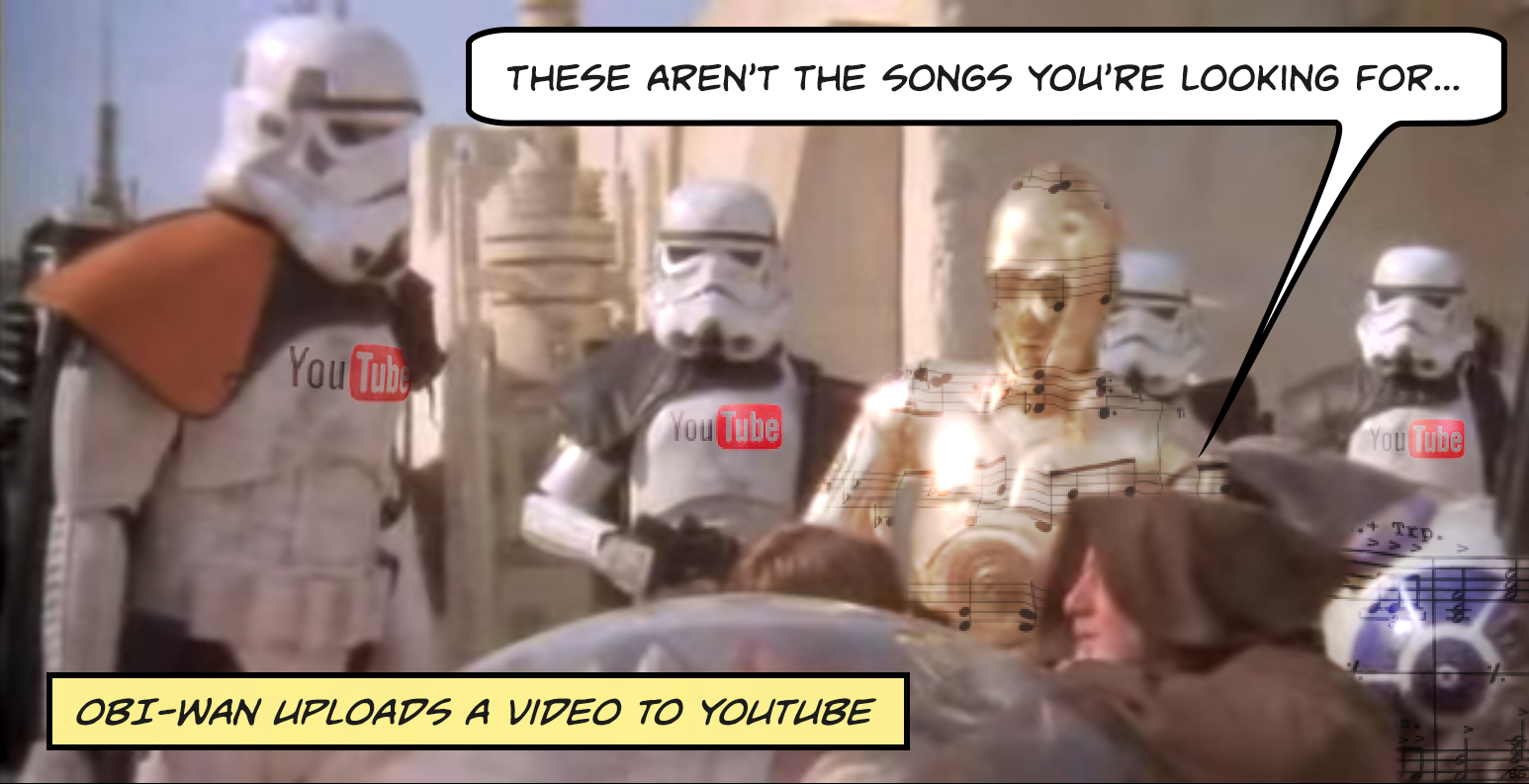
Ben Grosser, Music Obfuscator
At the behest of corporate copyright holders, media sharing sites like YouTube and Vimeo have implemented listening algorithms designed to identify uploaded music. However, these "Content ID" systems are designed to presume all use is illegal use; every match is automatically flagged, muted, and/or removed. The Music Obfuscator will enable users to hide music from Content ID. Each audio track submitted to the Obfuscator will be altered using a variety of signal processing techniques. The degree of alteration will be adjustable in order to accommodate changes in detection systems over time. How drastic will the changes need to be to evade detection? What kind of an aural world can exist on the edges of computational listening? The Music Obfuscator will help us understand the answers to these questions. The system will be web-based, allowing easy drag-and-drop of audio files, and—with permission—will archive obfuscated results for others to browse.
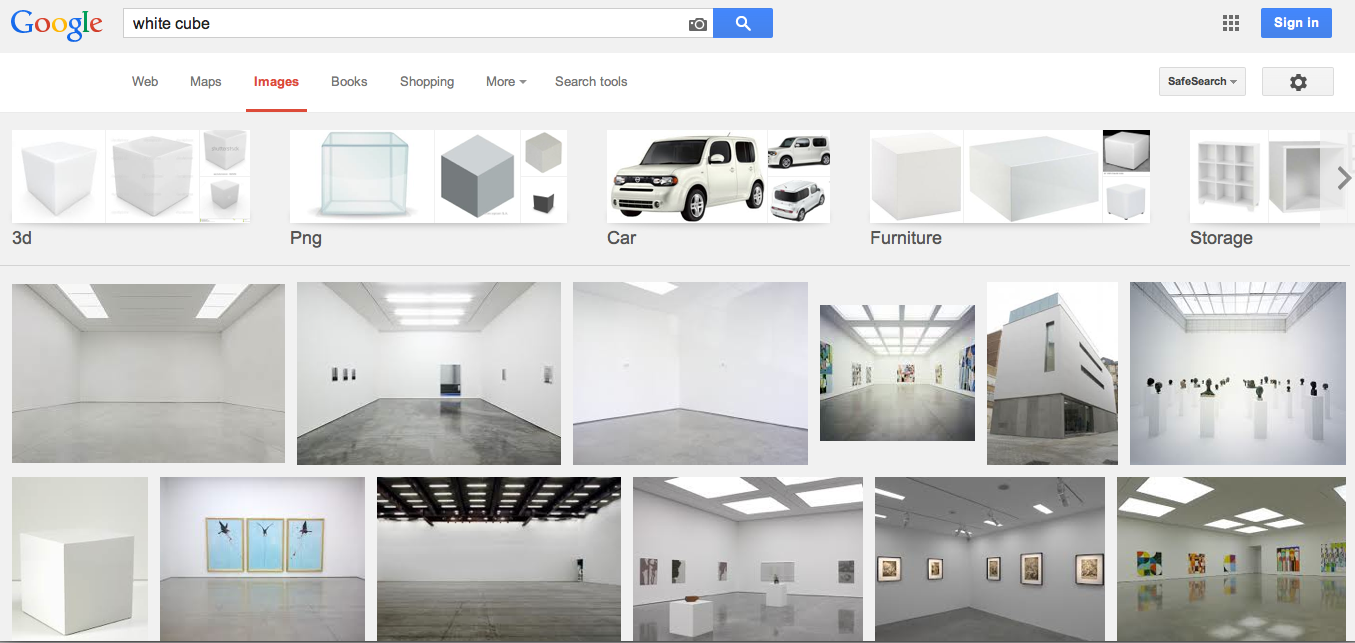
Christophe Barbeau, Internet's White Cube
Internet's White Cube The White Cube is an important structure in contemporary art. It is hard to deny the efficiency of this kind of context for presenting art. The White Cube is also an excellent adjuvant in our cognitive process of recognizing what we call Art. Even the institutional critique needs the Withe Cube as a symbol for the demonization of the institution. But what is the counterpart of the White Cube in the Internet ? Or in other words, what are the most common ways of entering into relation with art on the World Wide Web ? What are the specific strategies of artists creating internet-based artwork ? How is internet shaping what we are calling ART ? With my project, Internet's White Cube, I'm hoping to work on a structure for encountering Internet-based Art Work. No documentation of exhibition. The real deal on the Internet !

Deanna & Jack, Well, Actually: a journal of vernacular criticism!
Well, Actually: a journal of vernacular criticism! PDF based quarterly open to criticism as it exists in the field, nuance welcomed but not required! Available online for download. H/t to Brian Droitcour Edited by Deanna Havas & Jack Kahn
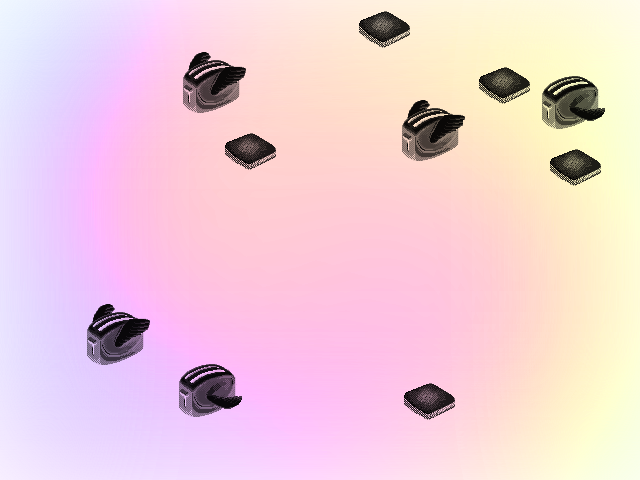
Emilie Gervais, Flying Toasters
I'm gonna make a website to fall asleep on & to, a website that says sweet dreams with flying toasters.
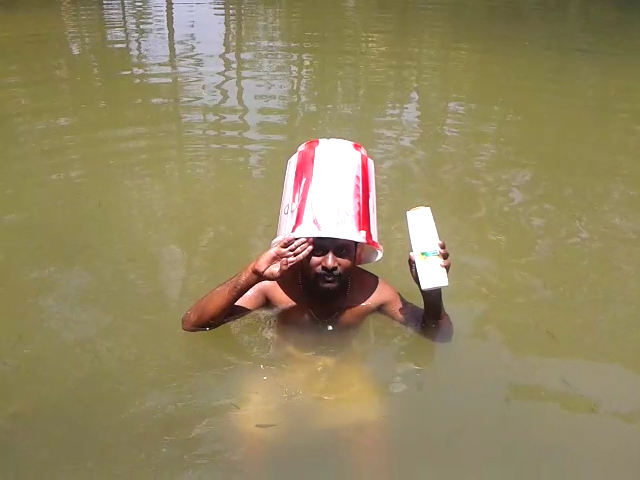
Eva and Franco Mattes, Bucket Salute
We will commission ten new performances called "Bucket Salute": you must be in the water, with a bucket on your head, a can in your hand, saluting. The performances will be part of our ongoing project BEFNOED: By Everyone, For No One, Every Day. The actions are carried out by anonymous workers we hire through crowdsourcing services, so we do not know who they are, where they are, or even their motivations. The resulting videos will be dispersed on social networks you may never have heard of, in Cambodia, Russia, China, South Africa… Links to new videos will be posted daily at http://befnoed.tumblr.com
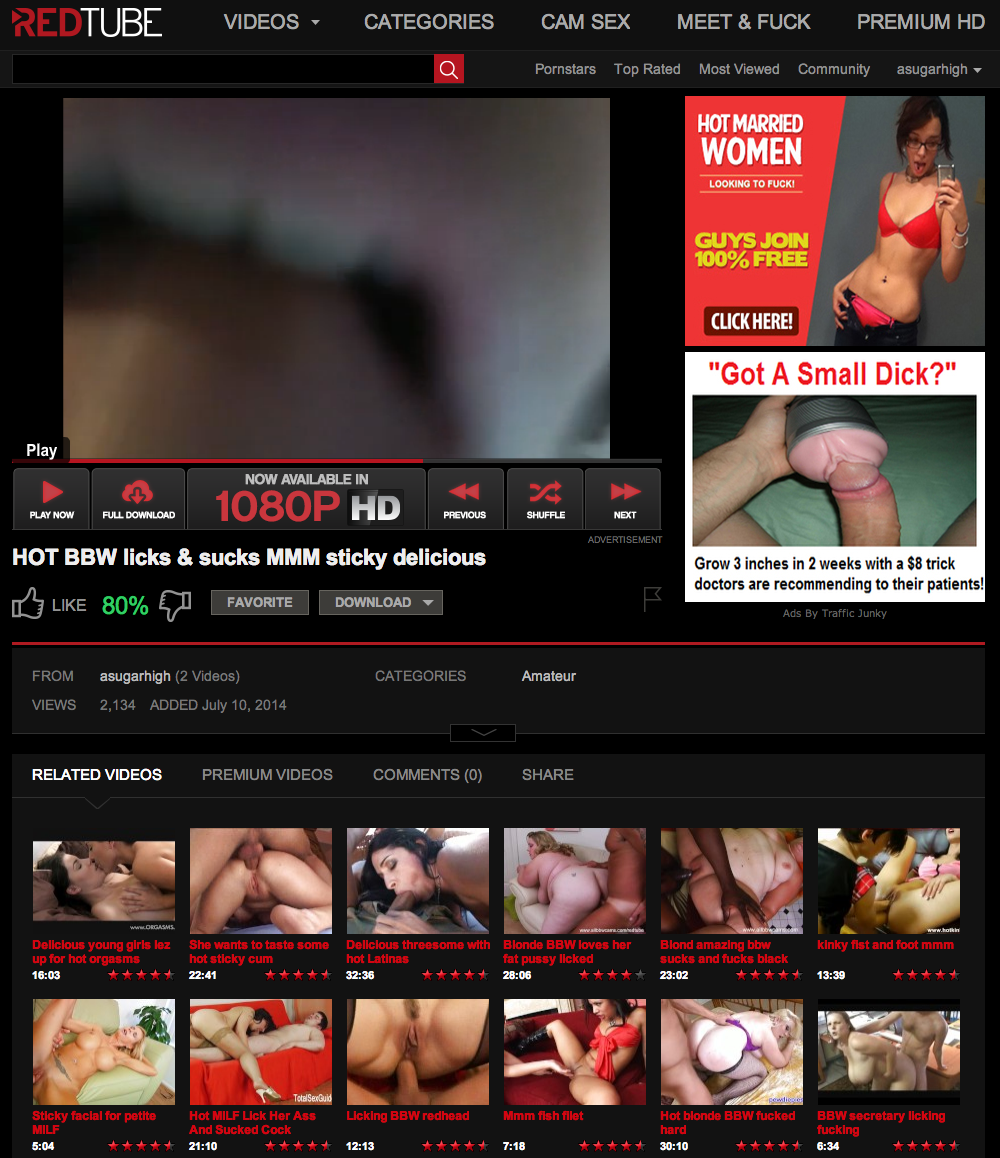
Faith Holland, Porn Interventions
Porn Interventions is a series of site-specific videos made for RedTube. The works invoke pornographic tropes but defy porn viewers' expectations. The videos are uploaded to RedTube using the site's own vernacular clickbait, with tags such as "solo girl," "BBW," "amateur," etc. I plan to produce a series for RedTube that explores the idea of technoeroticism. For example, several pieces will portray female anatomy grafted onto hardware. In an homage to Deep Throat, in which a woman's clitoris is displaced into her throat, I will "discover" that my audio jack has a clitoris and then fuck it with a microphone. I will also "masturbate" my webcam, treating it as a clit that comes to orgasm, but the image onscreen will be an abstraction produced by my fingers blocking the camera. Instead of the free flow of sexualized bodies, porn surfers are confronted with something critical, strange, and not very sexy.
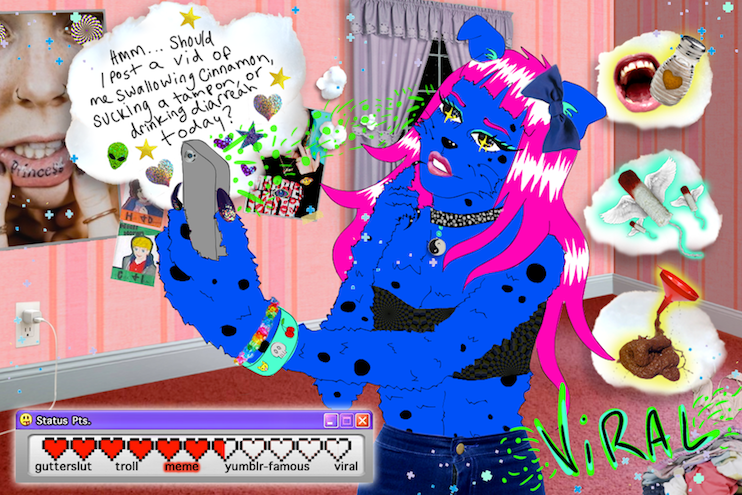
Lena NW and Julia Kunberger, Viral
"Viral" is a game that parodies celebrity status games (i.e. Kim Kardashian: Hollywood (app), The Urbz (PS2)) but focuses on the concept of becoming an Internet celebrity via social media. "Viral" hybridizes different types of gameplays: a quest/adventure, photography interface, dress-up, dating simulation, and personality quiz. The player can achieve 5 different levels of fame: gutterslut, troll, meme, "yumblr" famous, and viral. Through customizable performance identities, users have control over the "production" of their medias. For example, a user can choose to post a trendy chain video (i.e. cinnamon challenge), shock video, vlog, fake suicide video, etc. Each decision determines whether celebrity status points are increased or deducted. To boost status points, the user may also go on dates via the app "Cinder," post photos on "instacam", and upload videos to "glutube." "Viral" comments on status, performance, identity, and the narcissistic underpinnings of online personas.
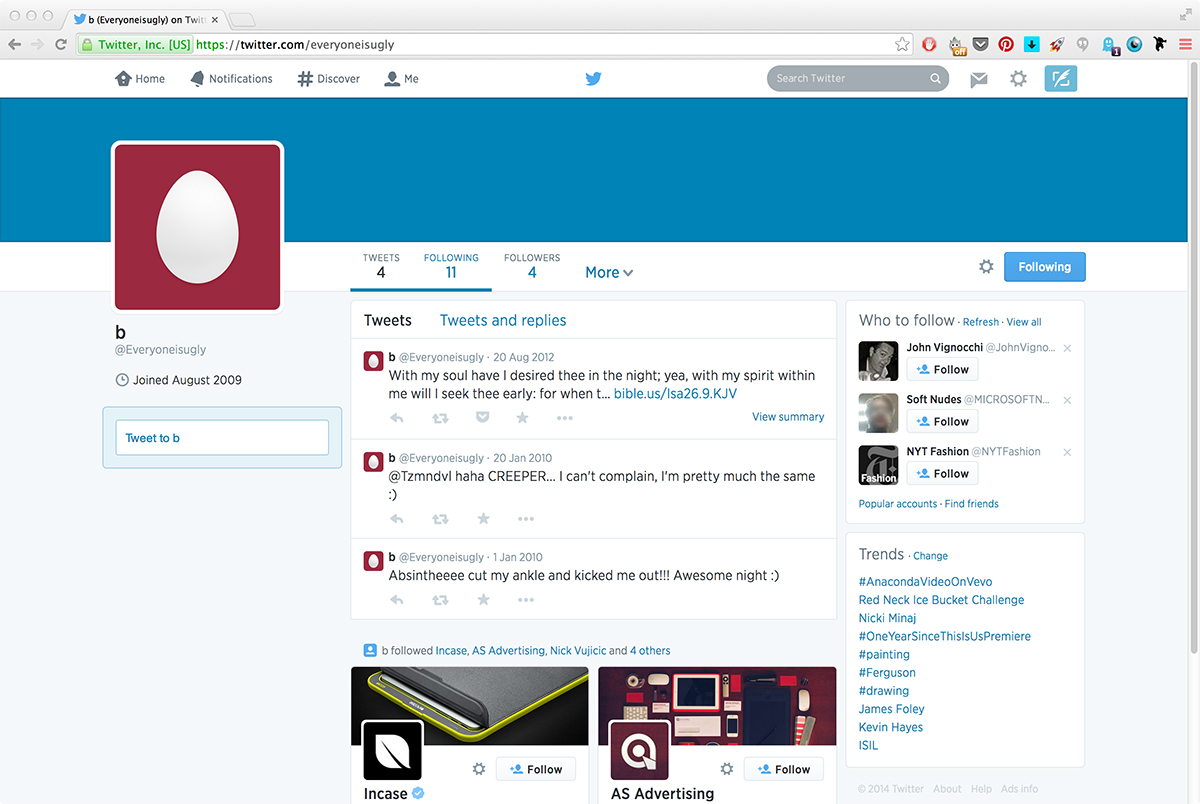
Martha Hipley, untitled Twitter hack
Some asshole is squatting on https://twitter.com/everyoneisugly which is really maddening since I own everyoneisugly.com and have http://instagram.com/everyoneisugly. Someone is also squatting on http://everyoneisugly.tumblr.com/. I have tried to contact both account owners politely so I can just buy the usernames, but whoever made them probably doesn't even have access to them anymore. It is super goofy that Twitter and Tumblr won't just free up dead accounts so I can have unified personal branding. I would use the Rhizome grant to hire someone to hack both accounts so I can delete them and have those usernames for myself. I would also do my best to document this as obnoxiously as possible so that I can likely get in trouble with both Twitter and Tumblr.
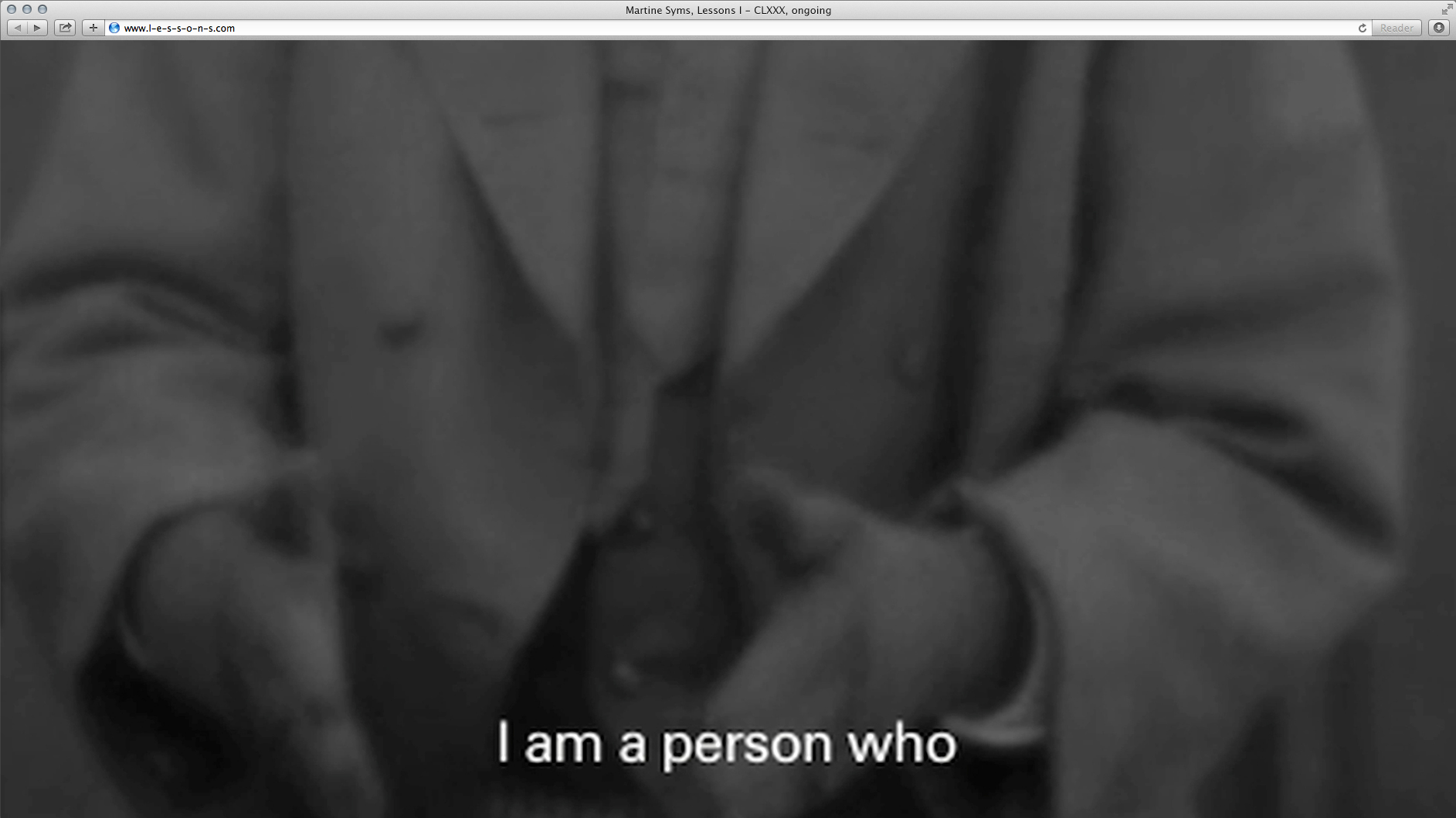
Martine Syms, Lessons
"Lessons" are an ongoing series of 30-sec videos that I refer to as "commercials." Watch here: https://vimeo.com/103862088. Each spot advertises a lesson I've learned from the tradition. Inspired by Fred Moten's writings on the musical break, the videos apply his ideas to the commercial break. The lessons resist the dominant logics of the cut, the figure, the voiceover, the frame. My goal is to create 180 videos in total. I'd like to present them as a continuous stream of full-screen videos at http://l-e-s-s-o-n-s.com. The videos will play in random order in an endless loop—an improvised edit, if you will. I will use the $500 micogrant to offset the costs of development and hosting.
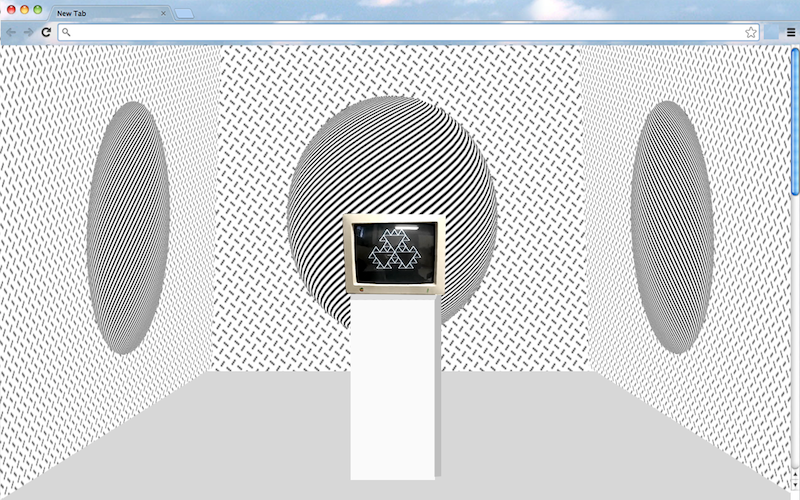
Melanie Clemmons, preservation support
The pace of technology's rapid fire progression causes a premature shift away from older versions of software/hardware. These pioneering technologies still haven’t been exhausted and hold merit in further exploration. The Media Archaeology Lab (MAL) in Boulder, CO claims similar logic, as their mission is to collect obsolete yet functional hardware and software. This past summer Zak Loyd and I have had the pleasure of working as artists in residence at the MAL. We giddily explored various computers/programs, realizing we weren't done with this technology before the newer forms became available. In an effort to document our work and to create a net art video-installation, we would greatly appreciate funding from the microgrant committee. We believe the internet is the right venue for our installation because we want to encourage the international community to revisit their older technologies with a creative and playful mindset. Thank you, Melanie Clemmons
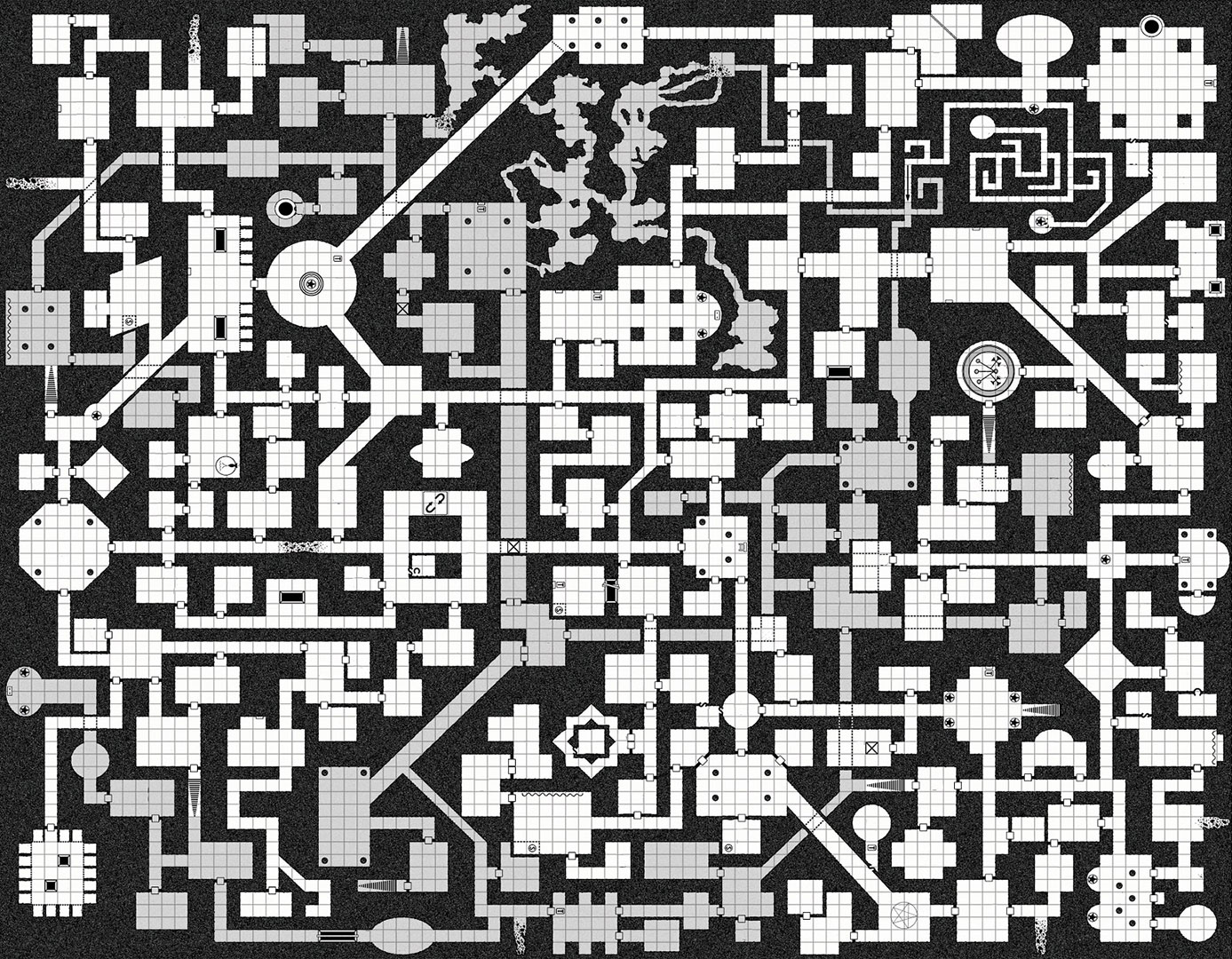
Peter Burr, CAVE EXITS
I aim to make a suite of static and animated screen works entitled CAVE EXITS. The series explores visual forms and psychological metaphors of the labyrinth, particularly highlighting the effects of using recursive feedback systems in the production of an image such as this: http://these.electricobjects.com/objects/2274. Rendered all in black and white, this series takes inspiration from a variety of sources including imaginary prisons of Giovanni Piranesi, Bridget Riley's early Op art paintings, and the framework of early computer graphics which necessitated a minimalist pixel-based approach towards their design. CAVE EXITS will launch as its own labyrinth in 2015 through an expanding website to be navigated hyperlink by hyperlink.
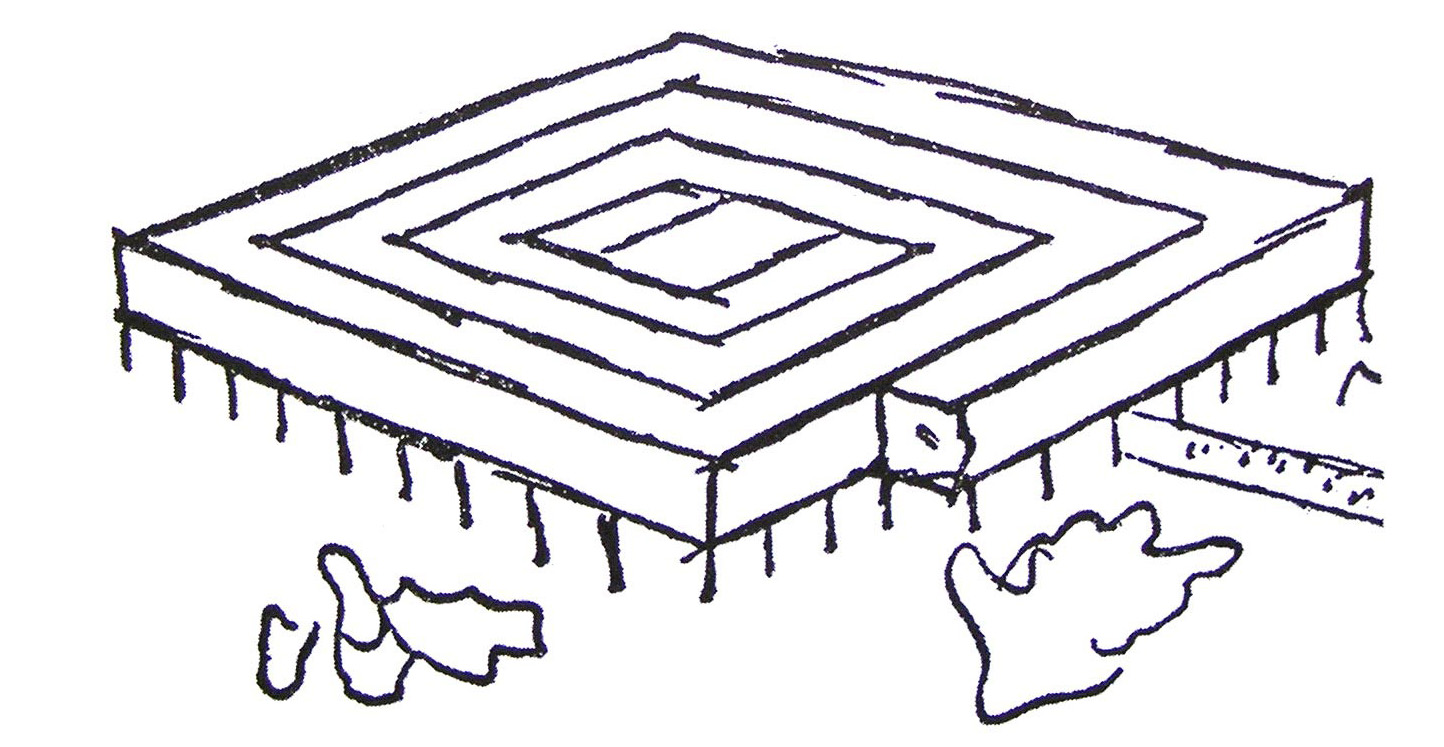
Robyn Bontempo, Every Ad on the Internet in 1985
Every Ad on the Internet In 1985, the UK House of Lords recommended that all public advertising be banned, with reference to “the manipulation of the human psyche within a functioning democracy." Every possible attempt will be made to collect and embed every-single-ad that has ever been, or will be placed on the Internet. The resulting immense single-page site will function as a constantly growing and endless design museum with millions of entries. Visually, you could think of something like "Million Dollar Homepage," except this frontier keeps growing, and most importantly, this one is for the people. The ads will be monetized: either per-click or per-view. The site is a gallery, a protest against visual pollution, and a monetized redistribution network against the concept of advertising itself. Hundreds of thousands of people will be employed to click through this universe, and the surplus profit will be distributed equally amongst all, handsomely-compensated, users.
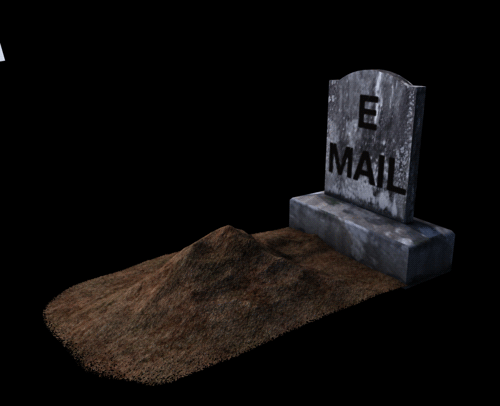
Scott Gelber, Foundations
"Foundations" is a project that pays tribute to early internet GIFs. I will solicit from artists and personally create updated versions of pixel GIFs from the early internet to be recreated with the latest digital tools. The project will show appreciation for early internet art pioneers and introduce & hopefully instill appreciation in generations that did not experience these works in their original context. I have created one of these already and if given this grant I would create a new site to showcase and share the original & recreated works http://time-cop.tumblr.com/post/53544947843/scott-gelber-unknown-skeleton-catching-e-mail
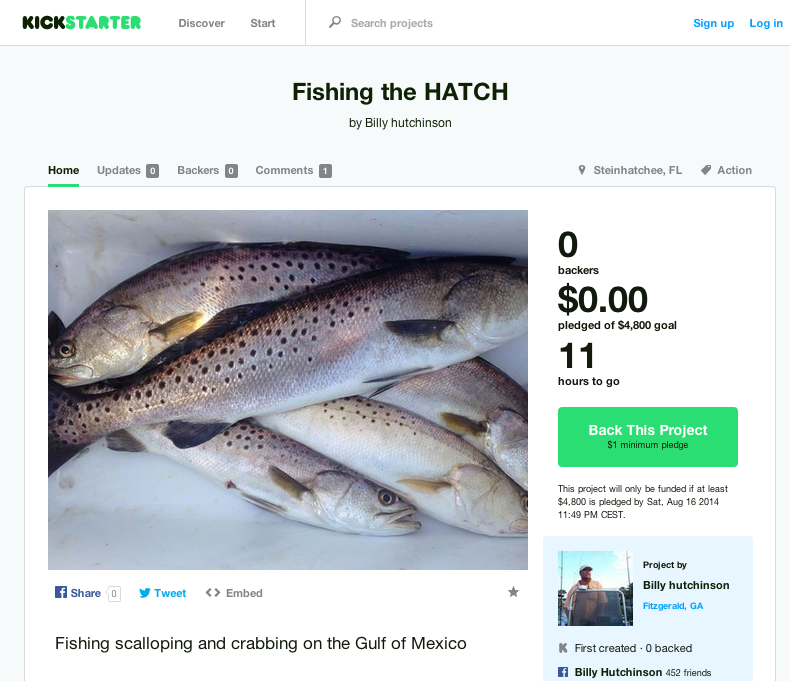
Silvio Lorusso, Kickended
"Kickended" is a website that randomly displays Kickstarter's $0.00-funded campaigns. Kickended is the place where unsuccessful campaigns with no backers can live a second life which is free from the pressure of money collection and has the purity of abstract ideas.
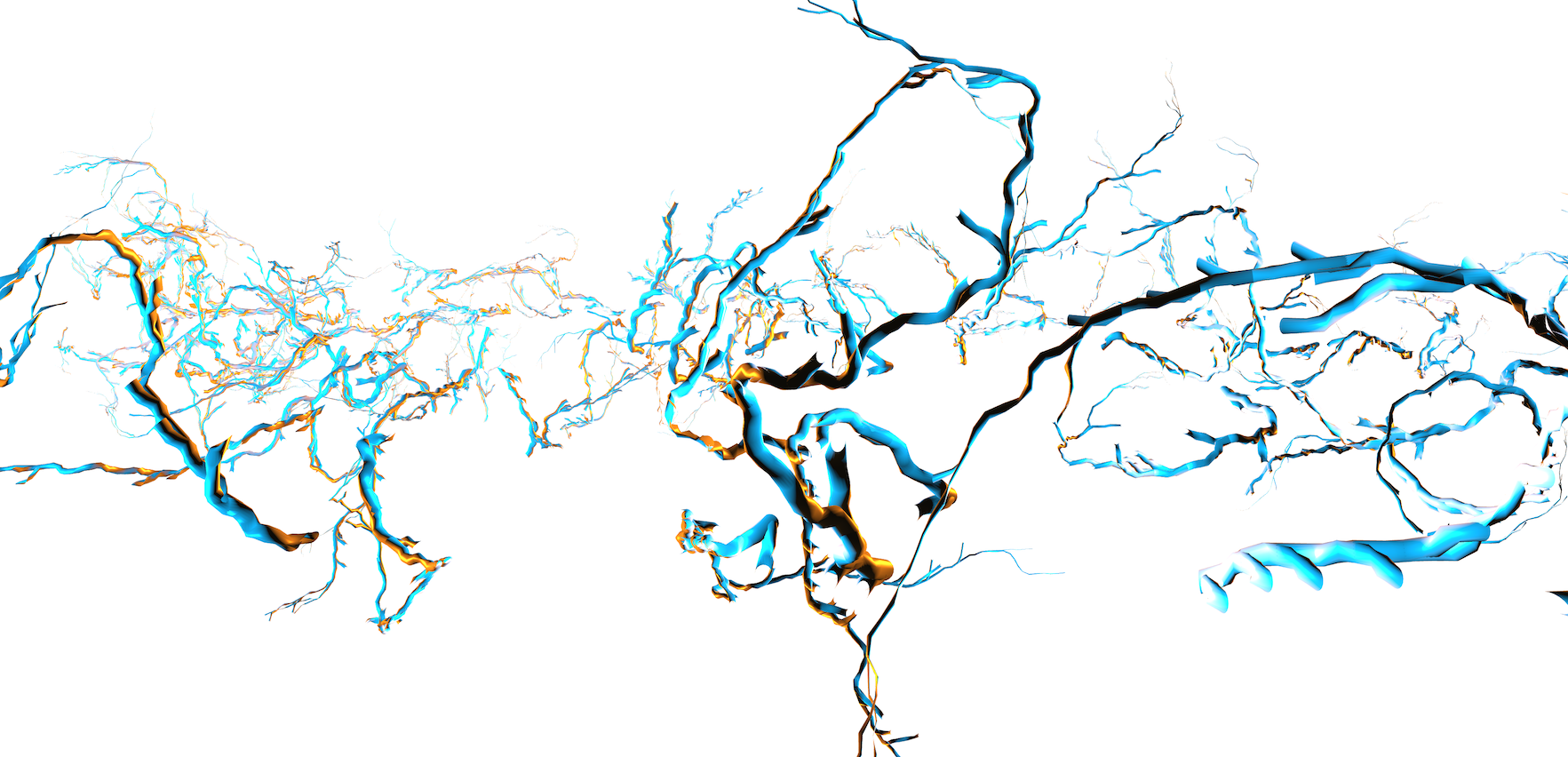
Sterling Crispin, Plein Air 002
This work is a web-based continuation of Plein Air 001, a project I completed in 2012, and these works are both sketches for a more active and alive algorithmic landscape I'd like to create. In this work I'm reimagining the ongoing contemporary expansion into cyberspace in the context of the colonization and expansion into the American West, and its depiction by the Hudson River School of painters, as well as the sublime as addressed by Romanticism. The land was a vast rugged territory waiting to be colonized.This raw expansiveness and infinite nature of reality in relation to the human body colors this sublime experience with terror and awe. In many ways cyberspace has already been colonized. Large multinational corporate entities have won, constructing vast architectures of information and light. Yet unlike the American West the frontier and wilderness of cyberspace is infinite, and itself expands with every boundary crossing.

#review